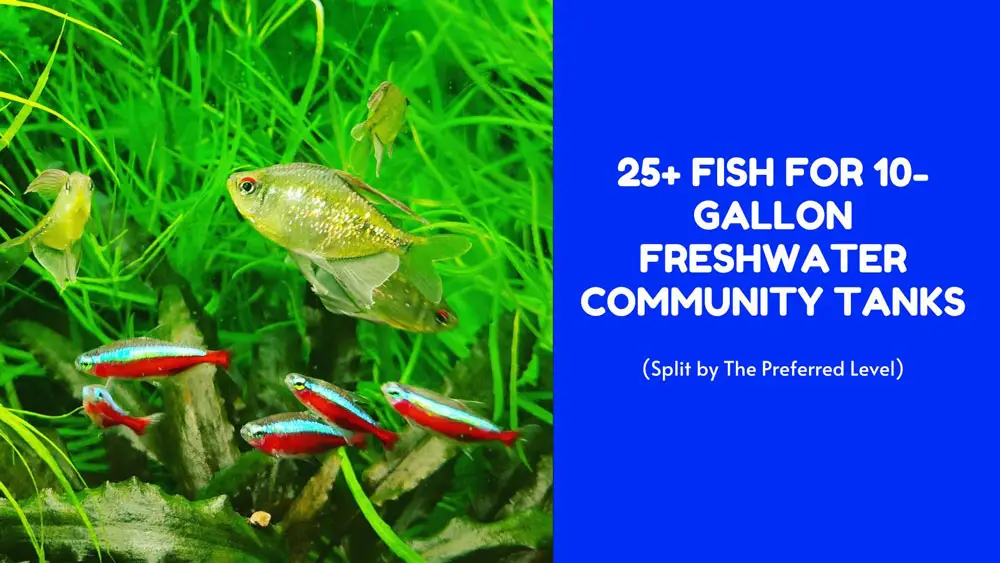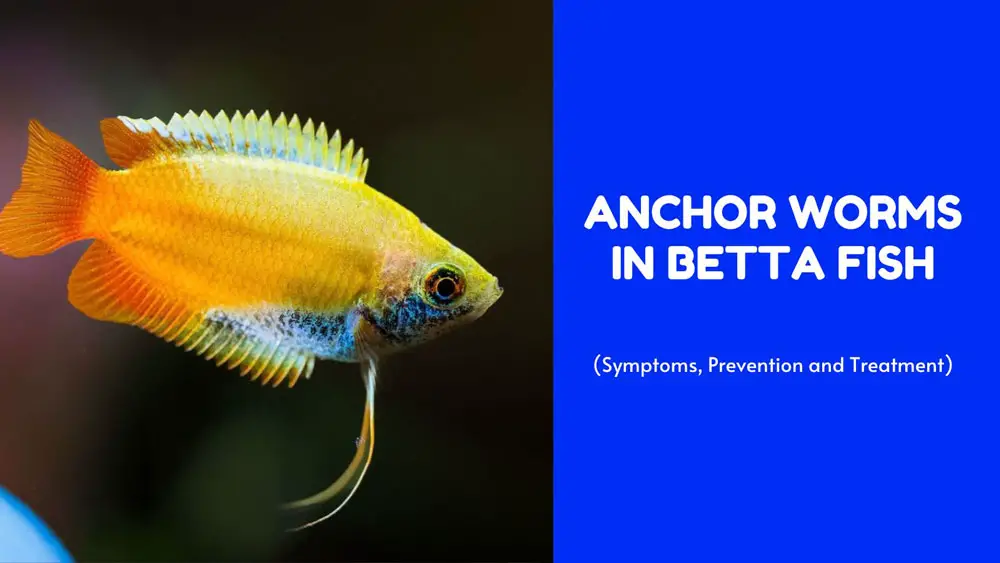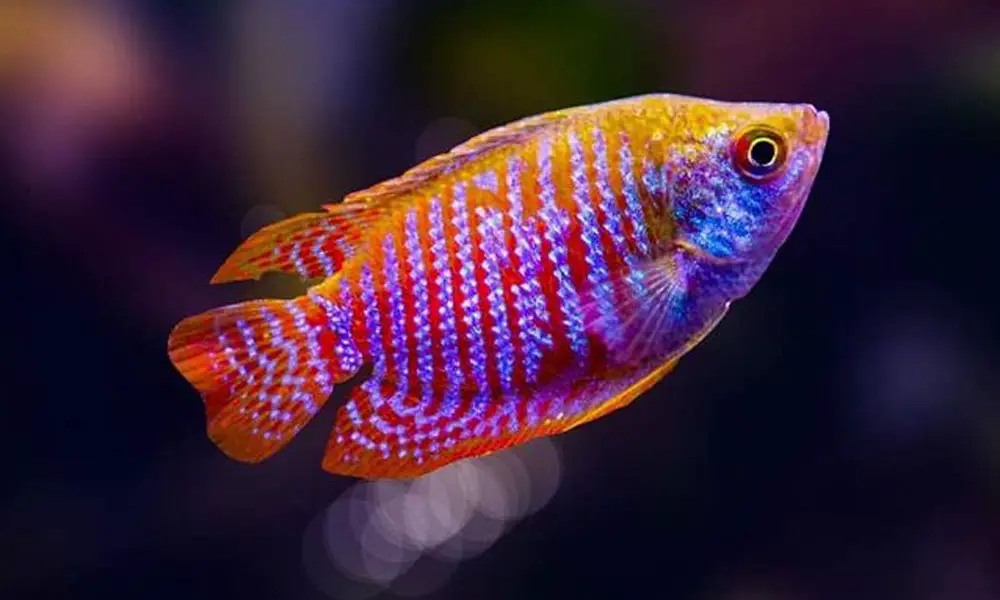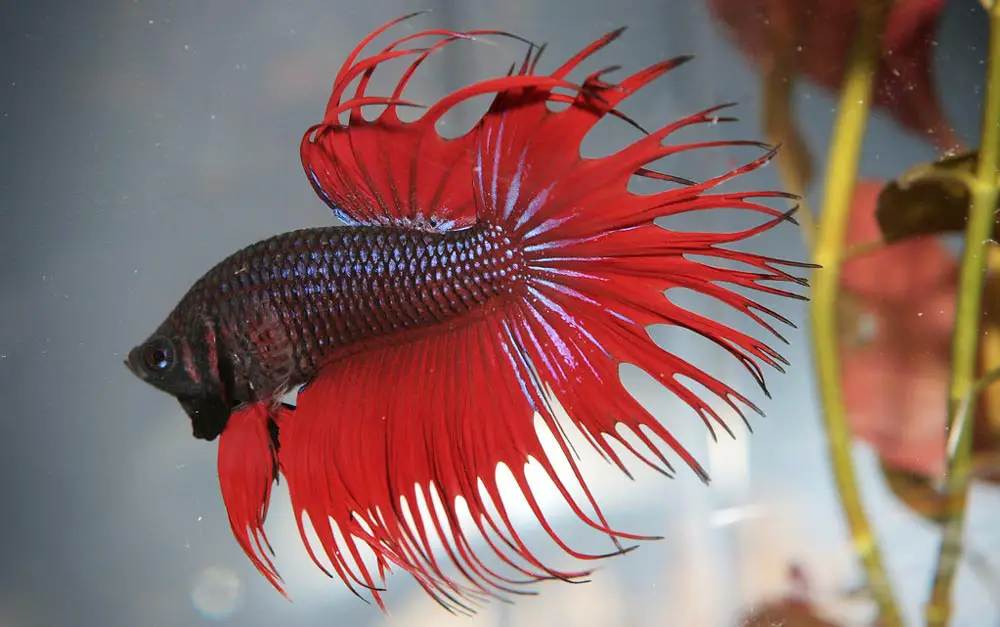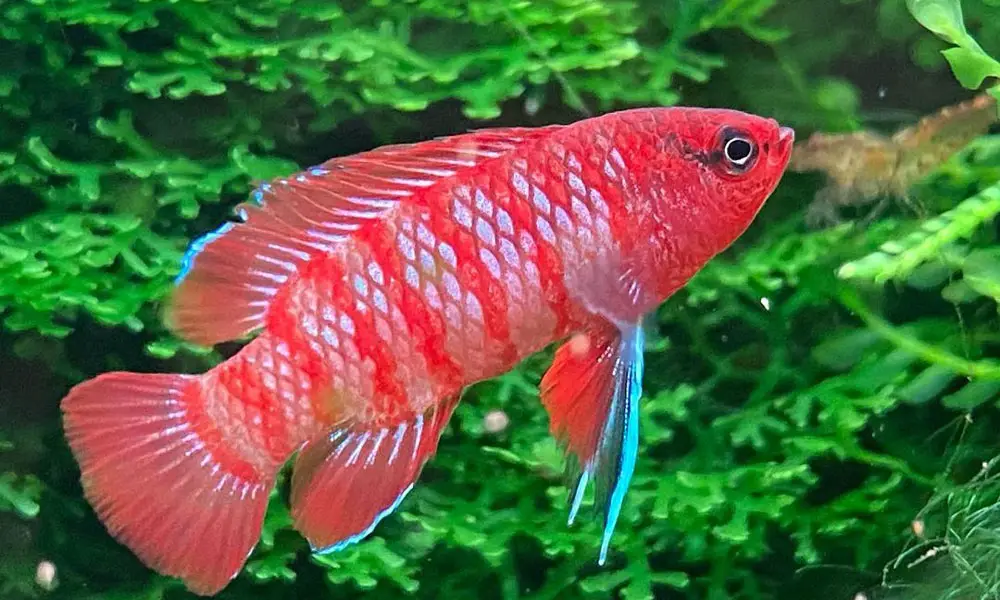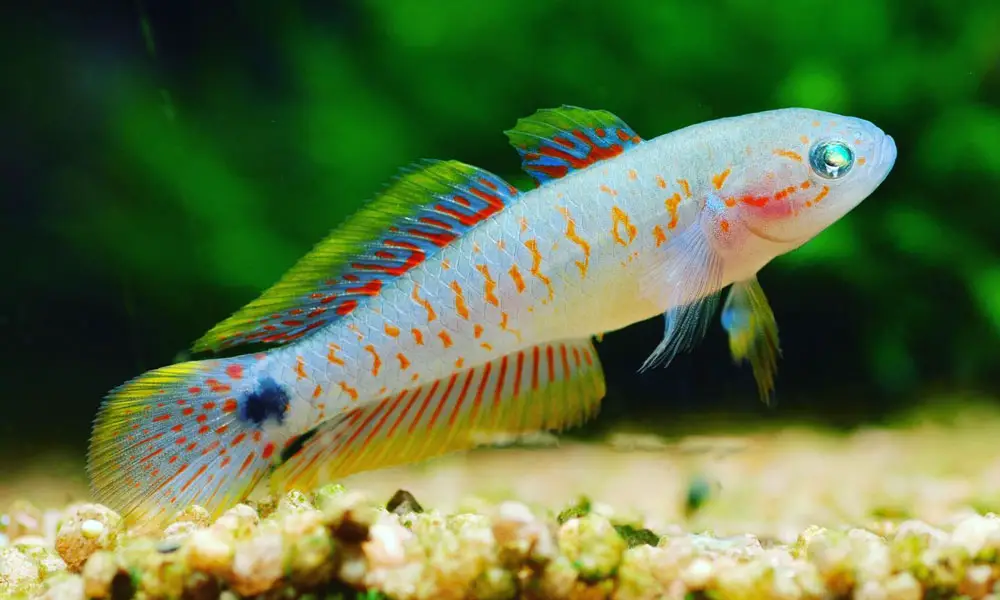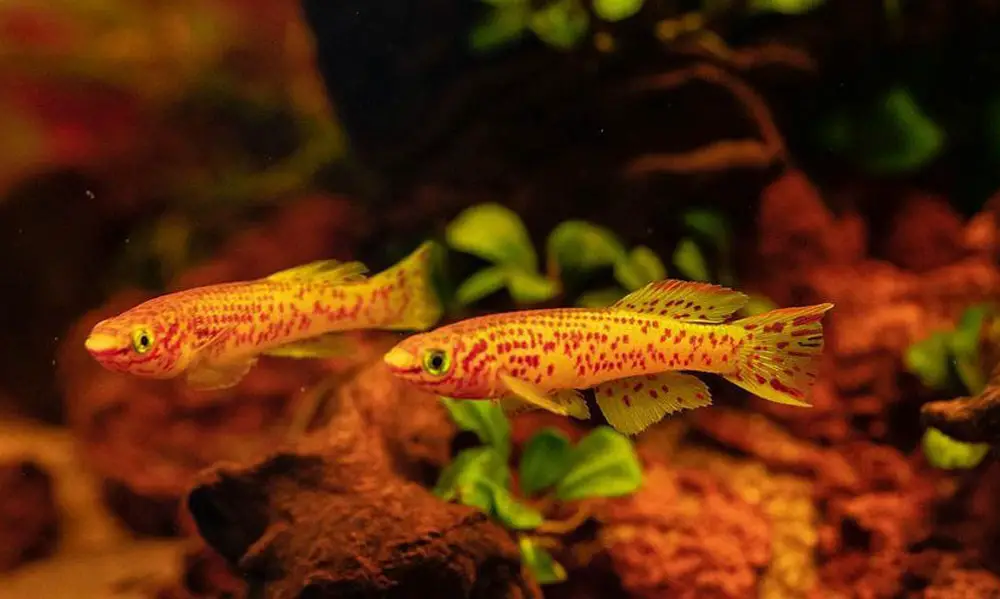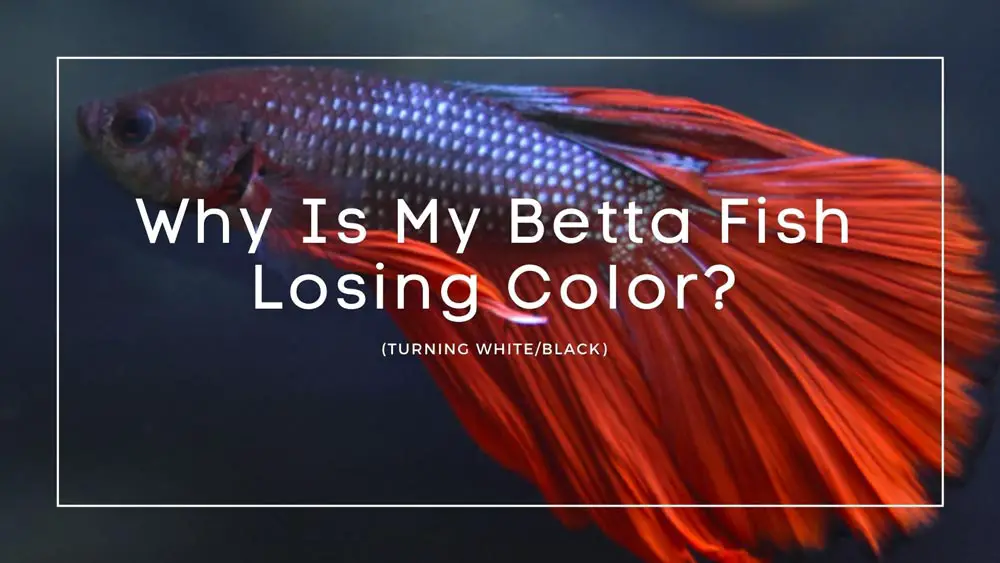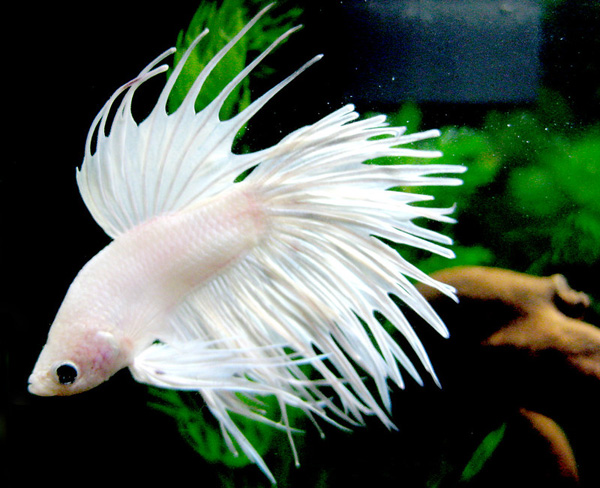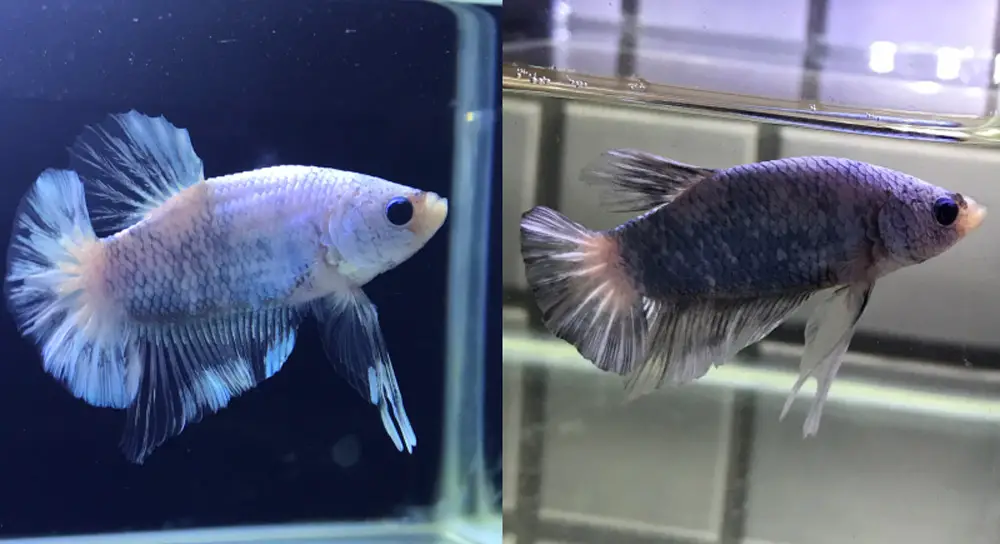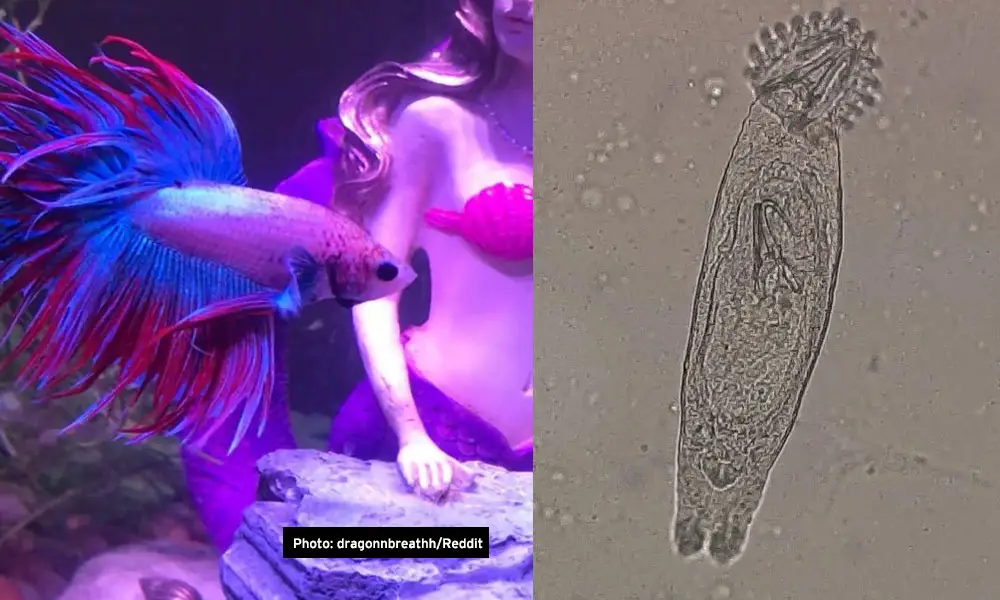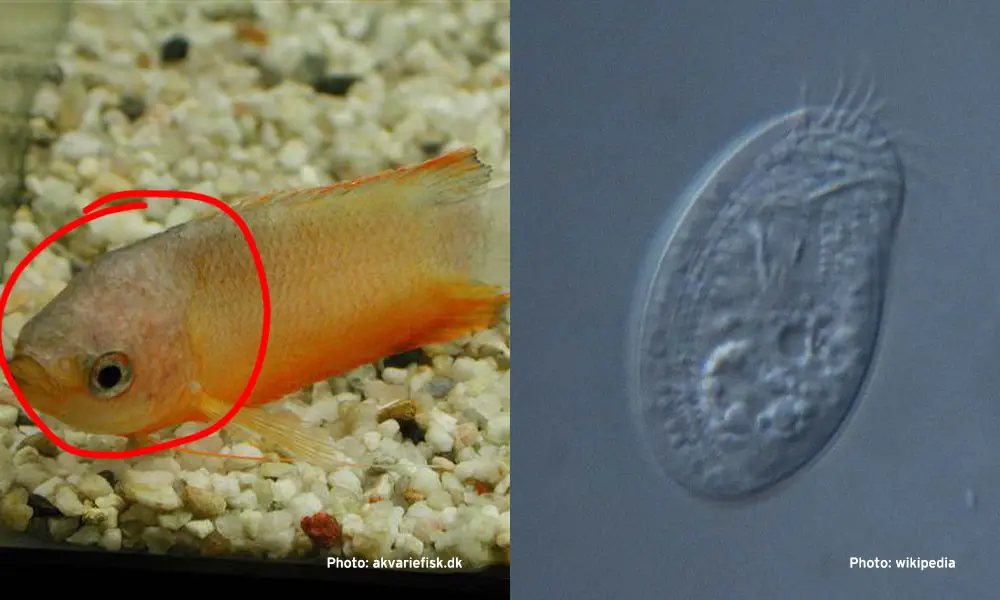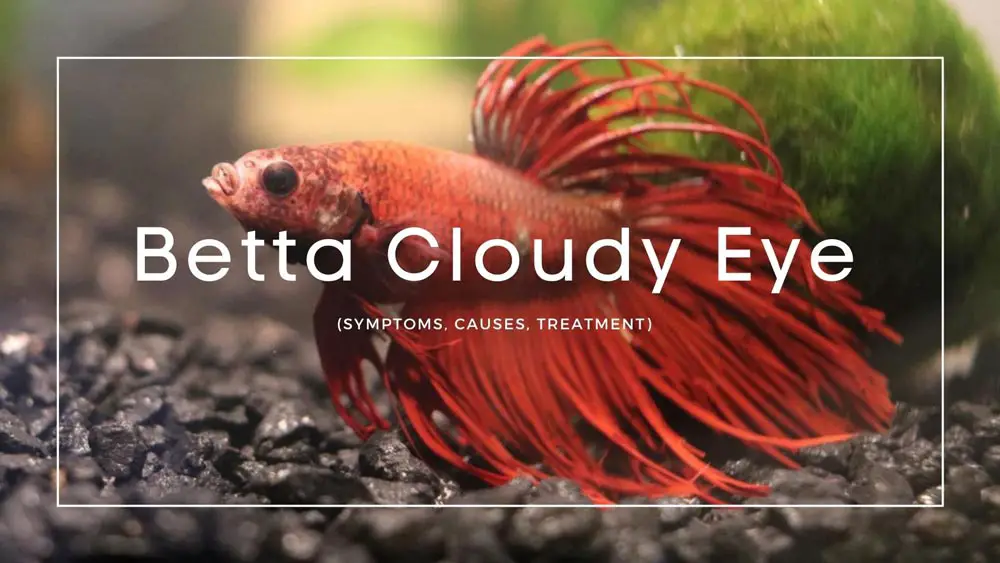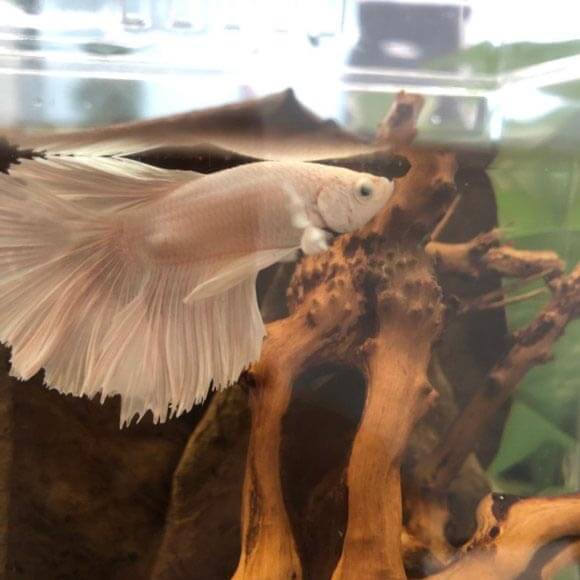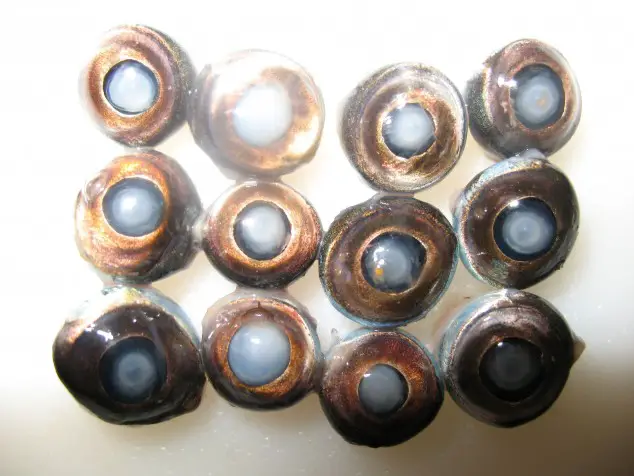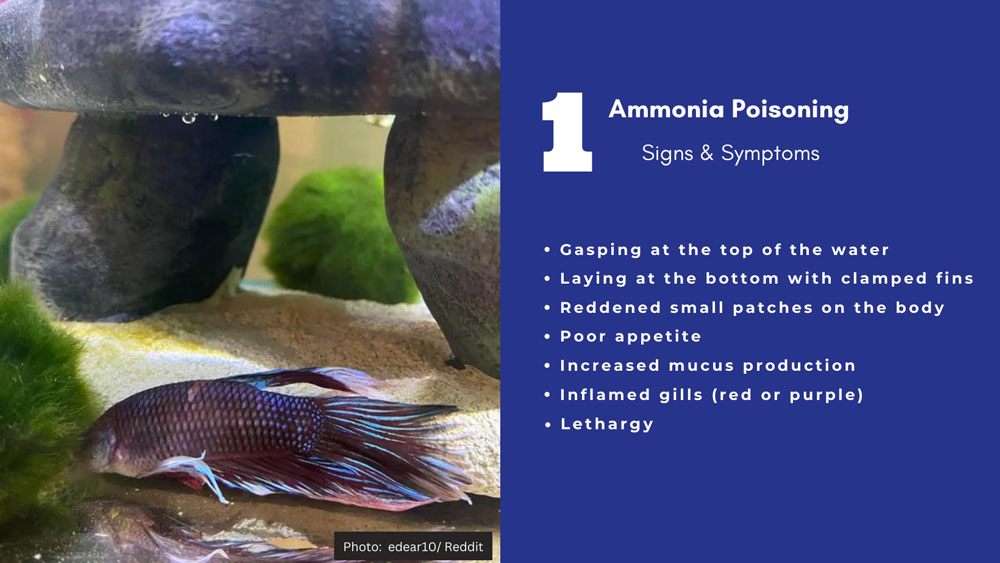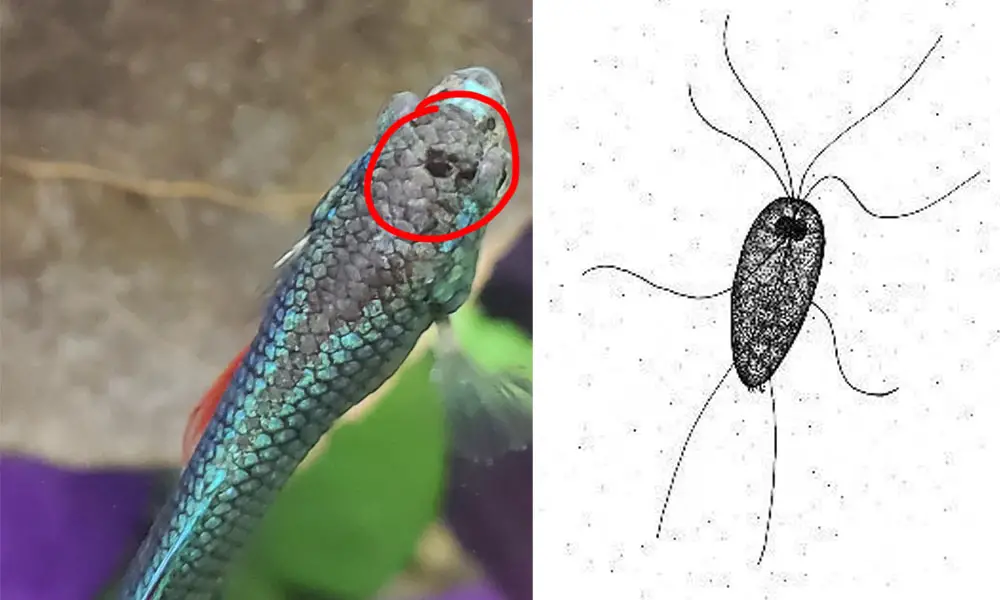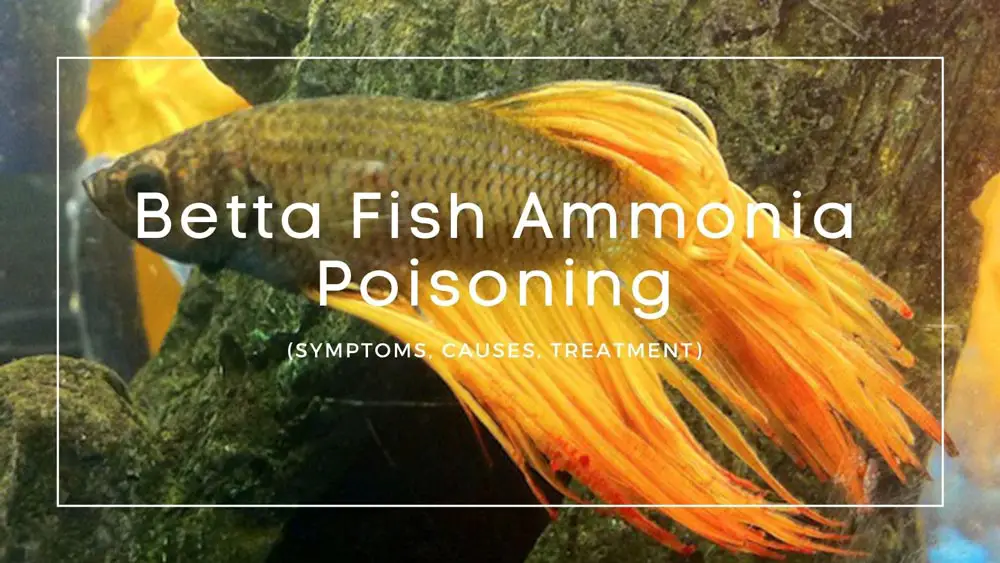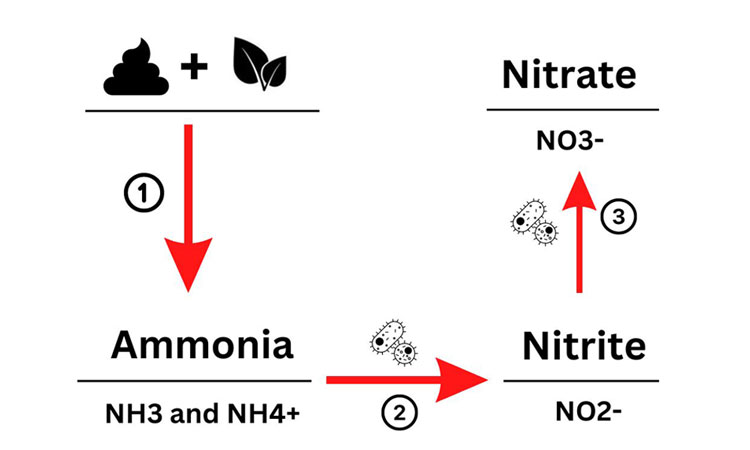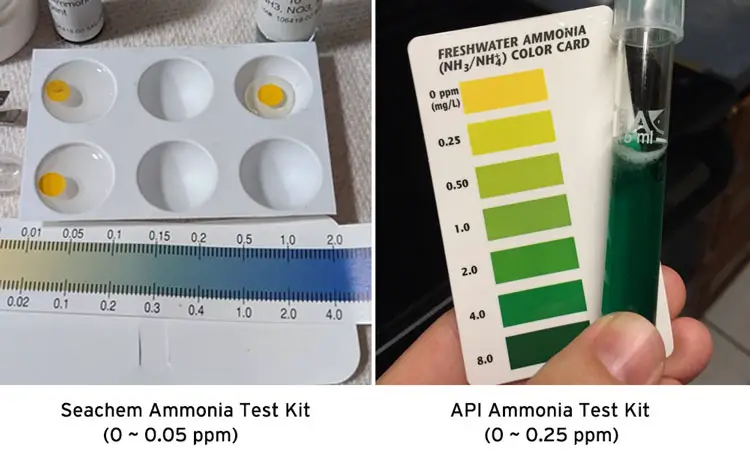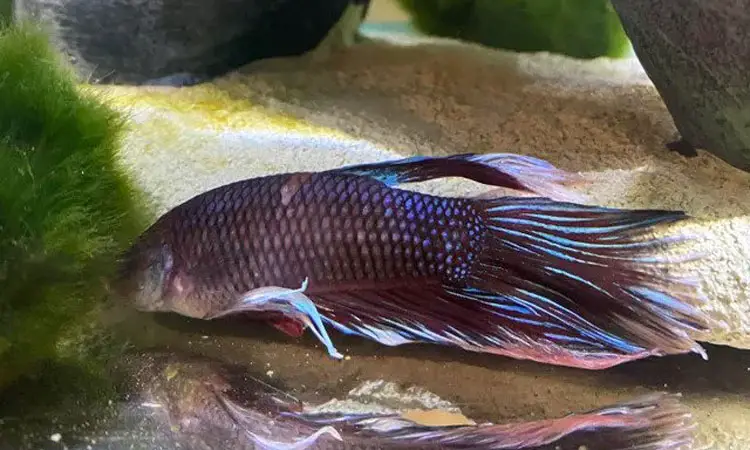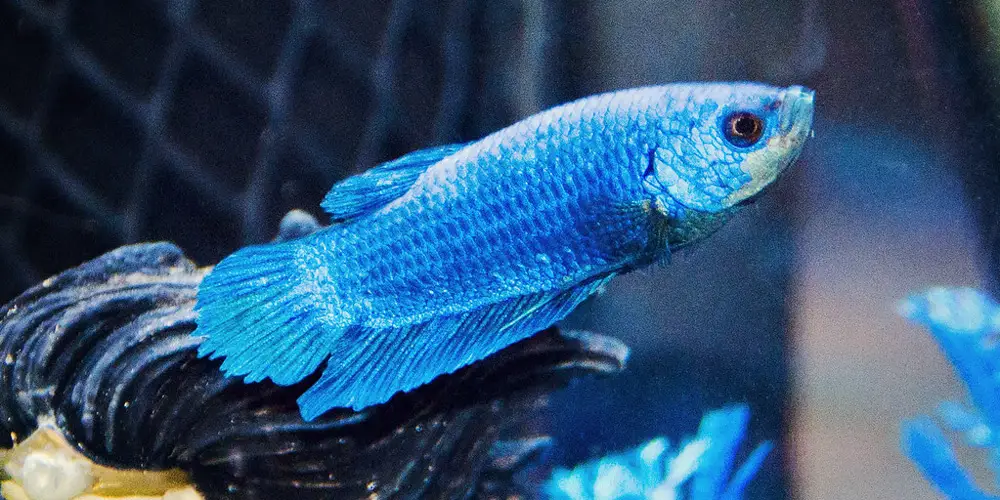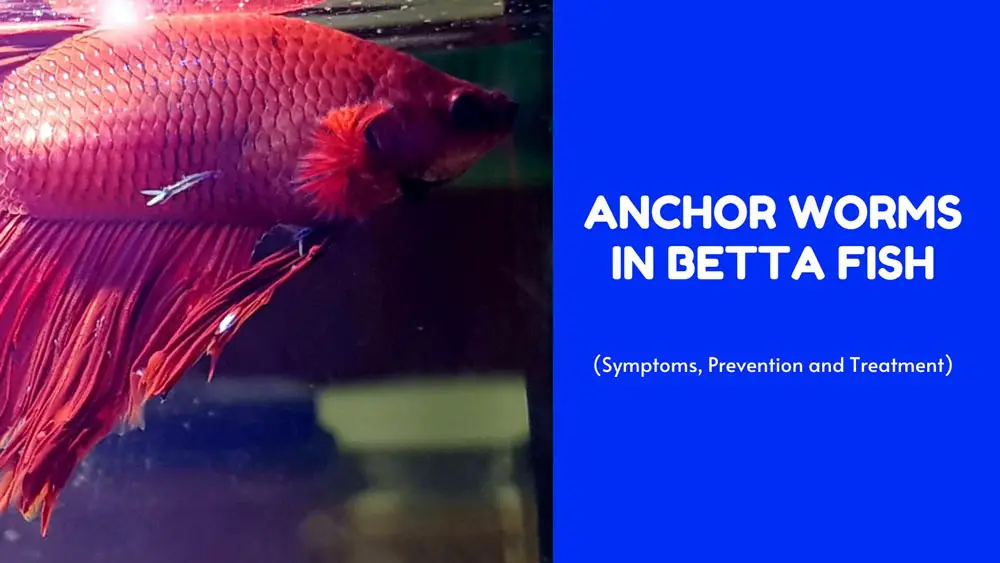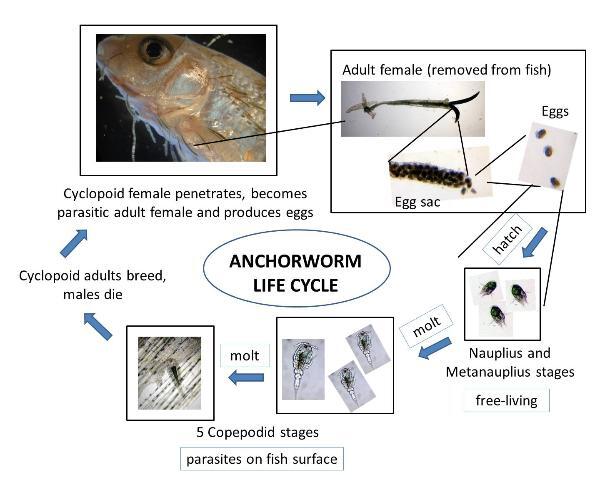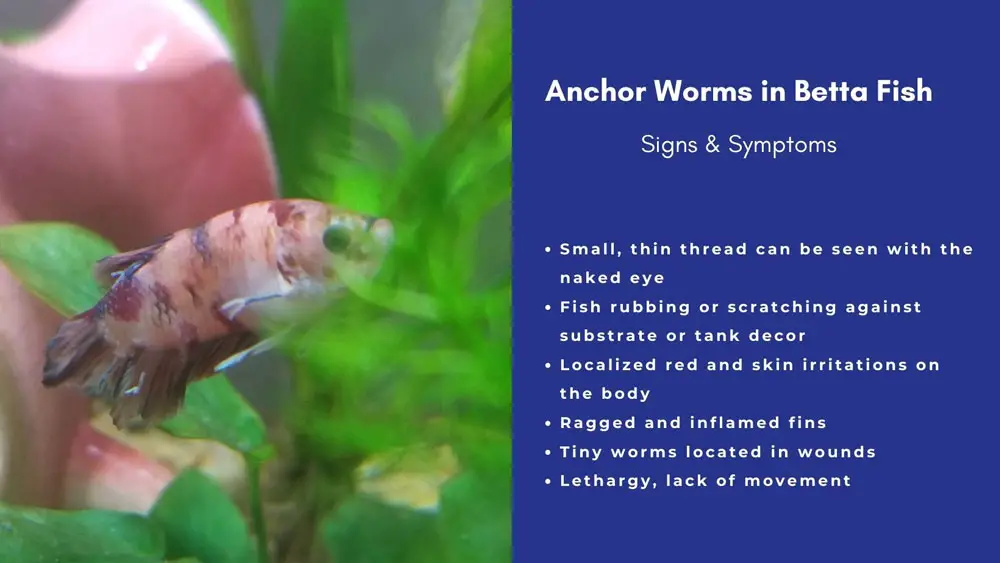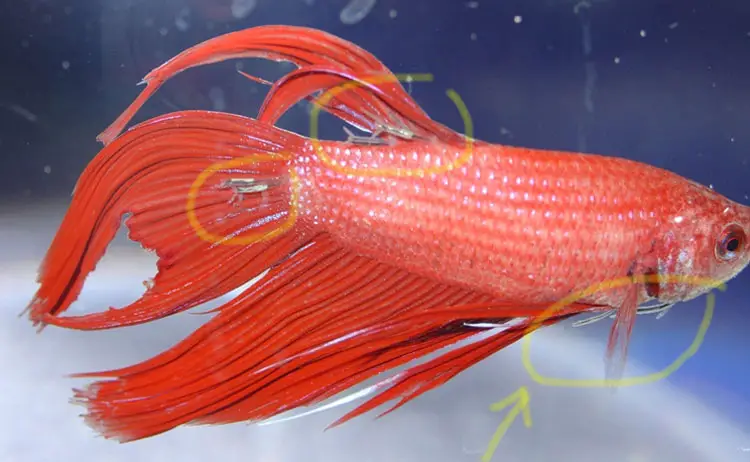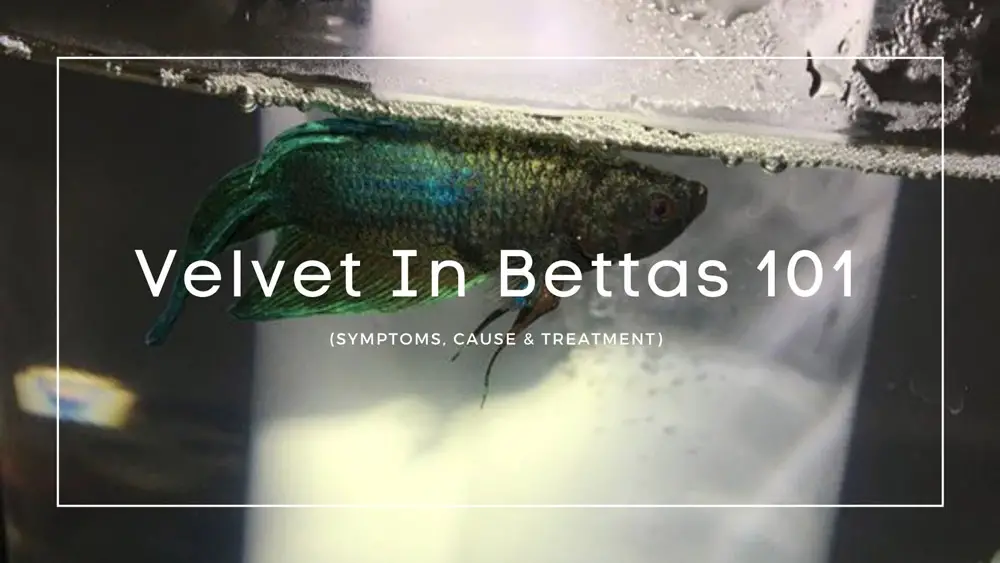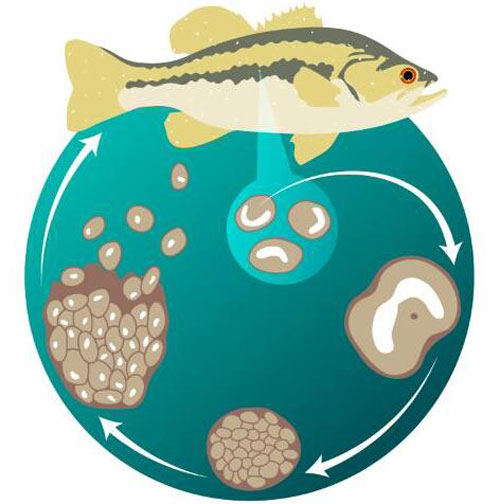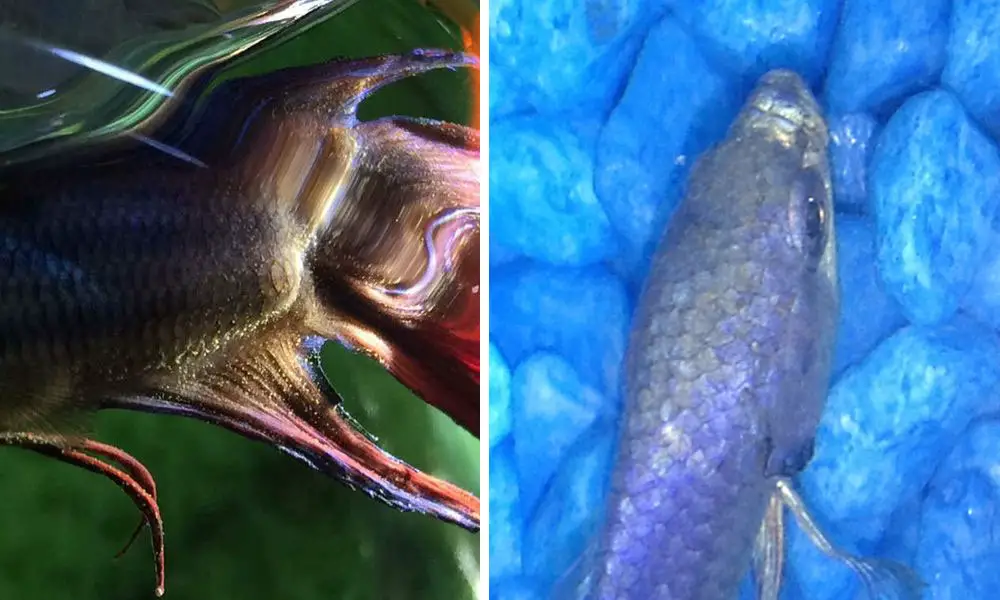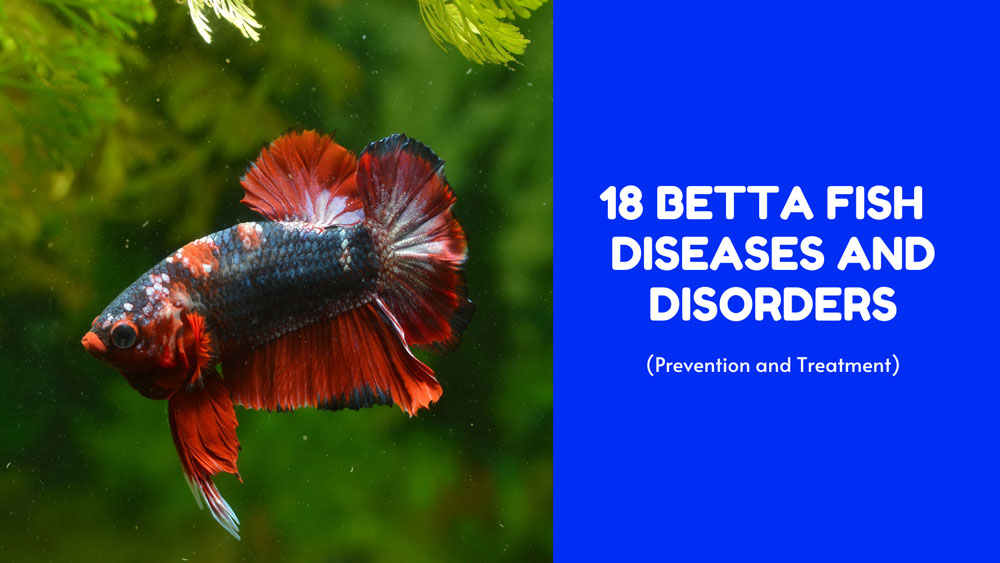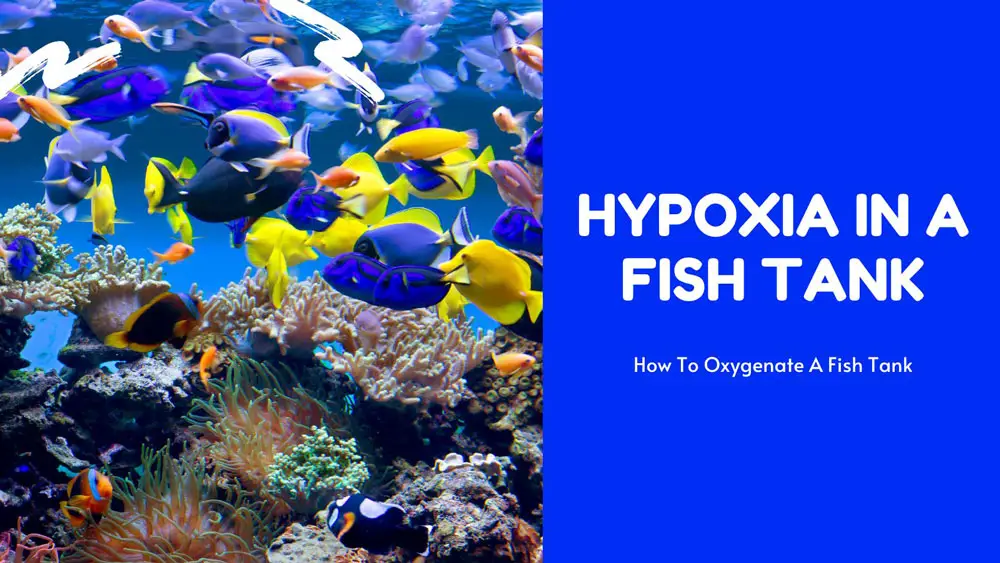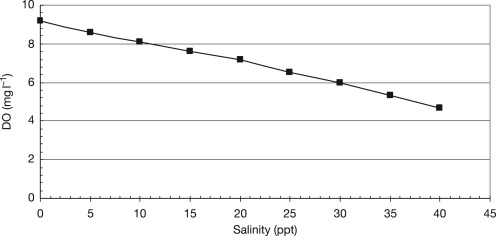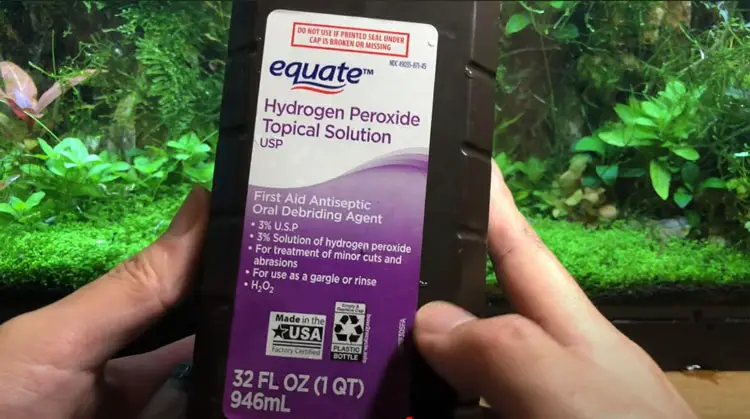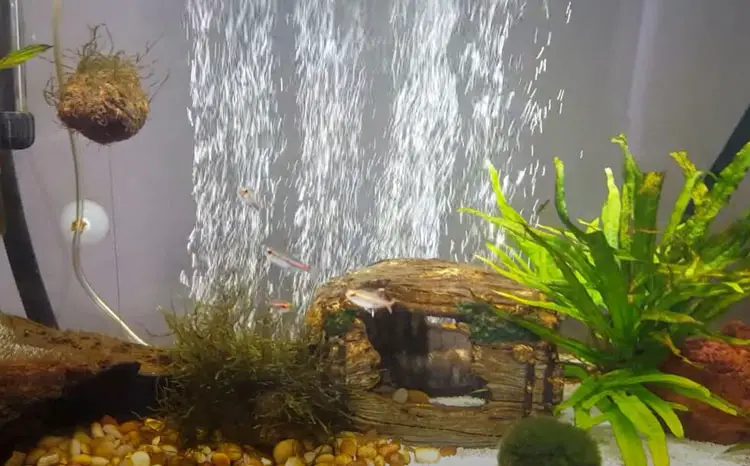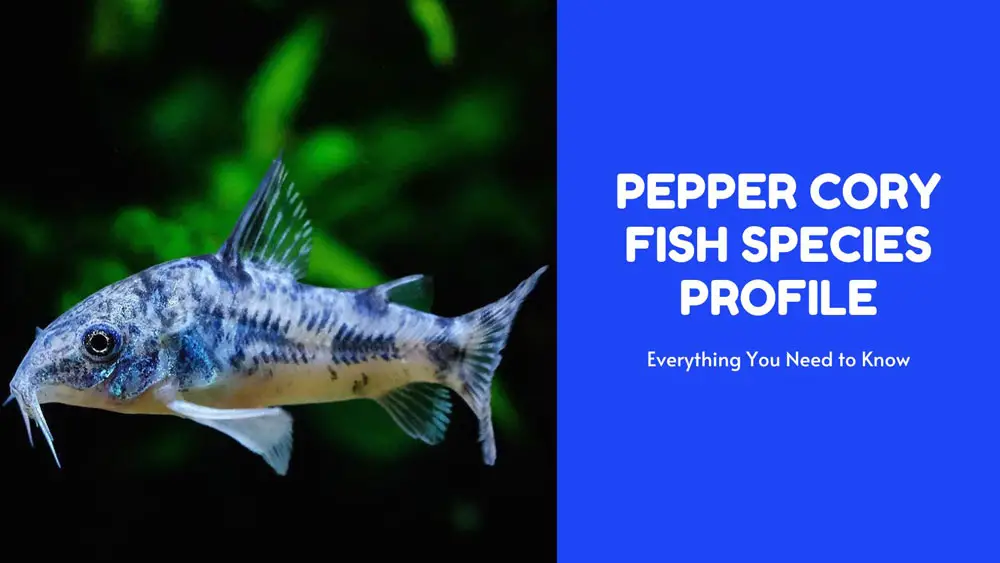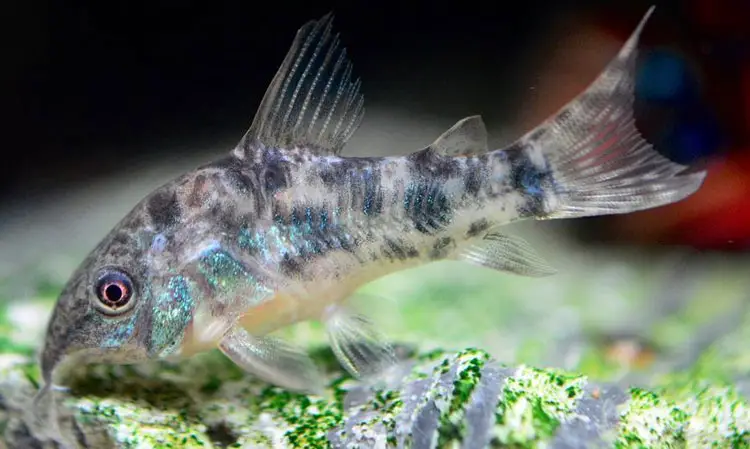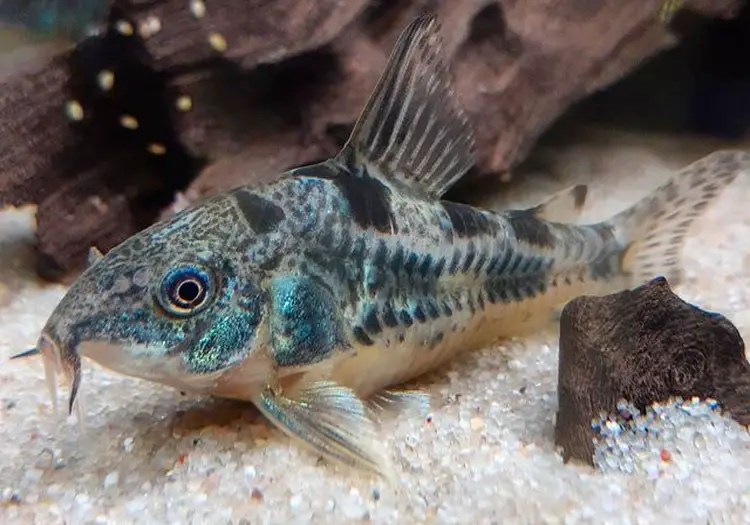A 10-gallon tank is popular amongst aquarists who are just starting out due to its compact size – virtually everyone can have one in their place.
From college dorms to nursing homes, tiniest apartments and even crowded classrooms, a nano aquarium is the perfect addition for those looking to add some fun and color in small spaces.
Unfortunately, the bad side of 10 gallons aquariums is that it can be challenging to find fish that are small enough to flourish in them.
That’s where this list will come in handy.
If you are planning to set up a 10-gallon community tank, here are 11 cool fish and critters that grow to suitable sizes and can make your mini underwater world come alive.
Any Level
There are quite a few species that are known for their vibrant colors, curiosity, and activity; they will likely move in all levels of the aquarium.
Upside Down Catfish (Synodontis nigriventris)
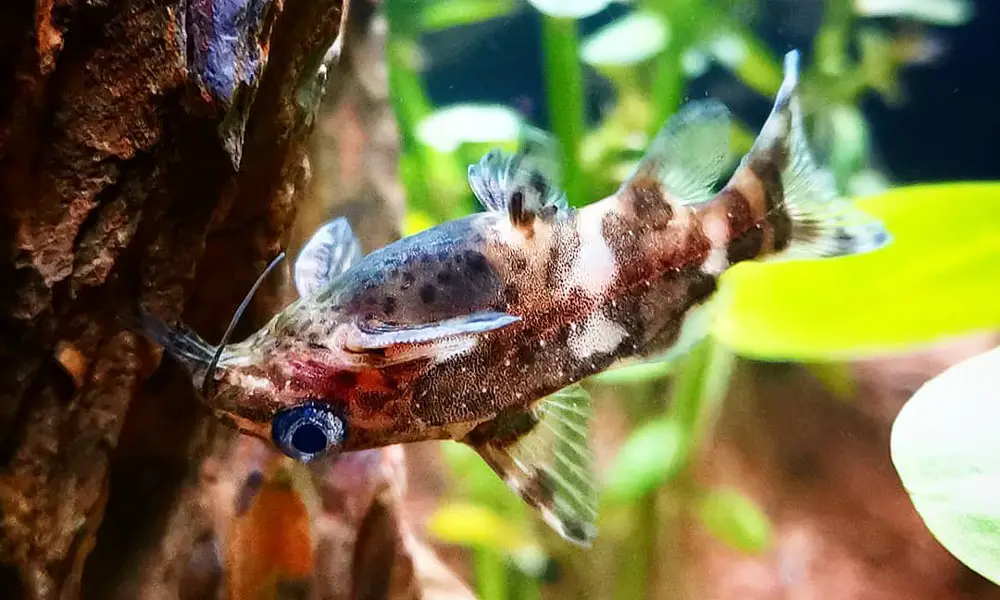
One of the smallest Synodontis species, the upside-down catfish (S. nigriventris ) gets its common name from its characteristic swimming patterns. Rather than swimming upright, this fish swims upside upside-down way!
These fish are not nano fish but can grow to 4 inches (10 cm) long and are best kept in small schools; However, you can still keep a single fish in a 10-gallon community tank even though it’s not recommended.
| Scientific Name: | Synodontis nigriventris |
| Common Name: | Upside-down catfish, blotched upside-down catfish |
| Origin: | Central Africa |
| Family: | Mochokidae |
| Size: | 4 inches (20 cm) |
| Social: | Peaceful |
| Care: | Easy |
| Lifespan: | 5 years |
| pH: | 6 to 7.5 |
| Temperature: | 72 to 79 F (22 to 26 C) |
| KH: | 4 – 15 dKH |
| Diet: | Omnivore |
| How Many Fish in A 10 Gallon Tank? | Single/A Pair |
White Clouds (Tanichthys albonubes)
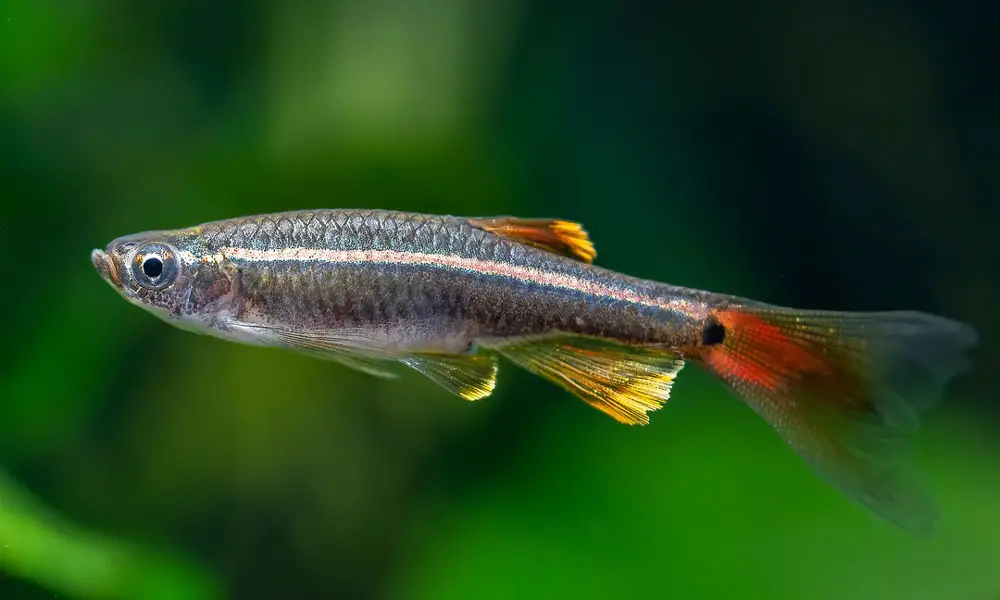
This 1.5-inch (4 cm) minnow has a striking appearance because of its shimmering brown body, white belly, a prominent iridescent white lateral line with black shadows, as well as brilliant red tail started with a large black dot.
Like most minnows, this fish should be kept in a larger school, preferably of a half dozen or more. For a 10-gallon aquarium, no more than four White Clouds should be added. In addition, white clouds are a coldwater fish that do not require a heated tank.
| Scientific Name: | Tanichthys albonubes |
| Common Name: | white cloud mountain fish, white cloud mountain minnow,Canton danio, Chinese danio, white clouds, |
| Origin: | China |
| Family: | Cyprinidae |
| Size: | 1.5 inch (4 cm) |
| Social: | Peaceful |
| Care: | Easy |
| Lifespan: | 3 to 5 years |
| pH: | 6.0 to 8.0 |
| Temperature: | 60 to 72 F (15 to 22 C) |
| KH: | 5 to 19 dKH |
| Diet: | Omnivore |
| How Many Fish in a 10 Gallon Tank? | 4 |
Zebra Danio (Danio rerio)
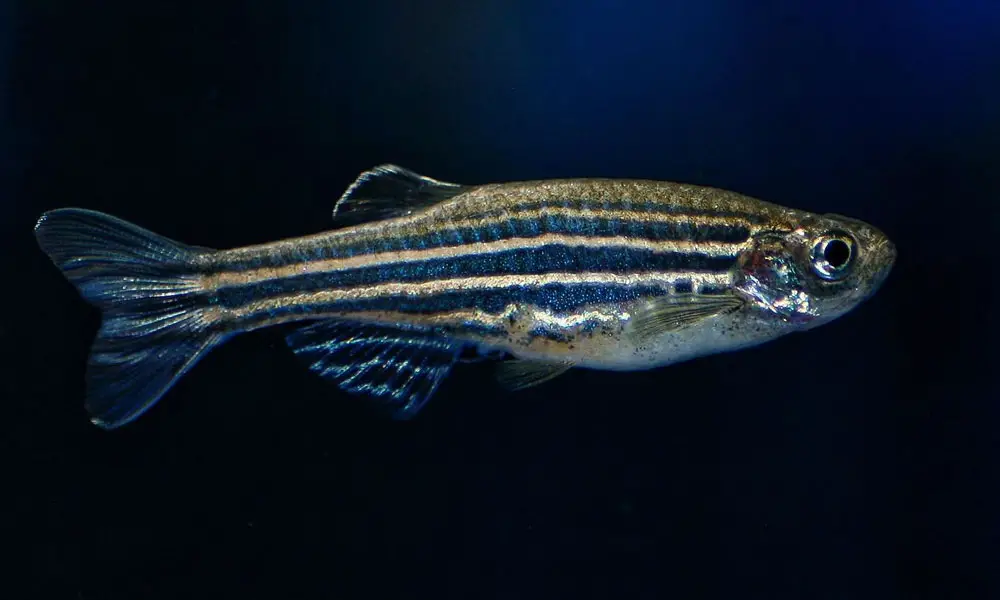
Hailing from India, zebra danio is one of my all-time favorite small community fish, which can be easily identified by its distinctive horizontal stripes that run across its body.
These small but active fish can grow to about 2 inches (5 cm) in length and stay relatively peaceful when kept in a school of 4 or more individuals. They are easy to care for and prolific, making them ideal for first-time breeders.
| Scientific Name: | Danio rerio |
| Common Name: | Striped danio, zebra danio, zebrafish |
| Origin: | India |
| Family: | Cyprinidae |
| Size: | 2 inches (5 cm) |
| Social: | Peaceful |
| Care: | Easy |
| Lifespan: | 3 to 5 years |
| pH: | 6.5 to 7.0 |
| Temperature: | 64 to 74 F (18 to 24 C) |
| KH: | 5 to 12 dGH |
| Diet: | Omnivore |
| How Many Fish in a 10 Gallon Tank? | 4 |
Top to Mid-dwelling Fish
The mid to top levels of the aquarium should be populated with vibrant, active fish to create a captivating focal point.
The most commonly kept mid to top species include:
Black Neon Tetra (Hyphessobrycon herbertaxelrodi)

Tetras, also known as characids, are the most colorful and lively options for the middle level of a community tank. Black Neon Tetras are a staple in the aquarium trade because of their pleasant personality and contrasting colors.
This schooling fish can grow to 1.5 inches (3 cm) in length and prefer to be kept in schools of six or more individuals. Consider keeping this energetic fish if you want to add a splash of vivid colors in your 10-gallon community aquarium with plenty of plants and a dark background.
| Scientific Name: | Hyphessobrycon herbertaxelrodi |
| Common Name: | Black tetra, neon tetra, black neon |
| Origin: | Brazil |
| Family: | Cyprinidae |
| Size: | 1.5 inches (3 cm) |
| Social: | Peaceful |
| Care: | Easy |
| Lifespan: | 3 to 5 years |
| pH: | 5.5 to 7.5 |
| Temperature: | 73 to 81 F (23 to 27 C) |
| KH: | 0 to 6 dGH |
| Diet: | Omnivore |
| How Many Fish in a 10 Gallon Tank? | 6 |
Green Neon Tetra (Paracheirodon simulans)
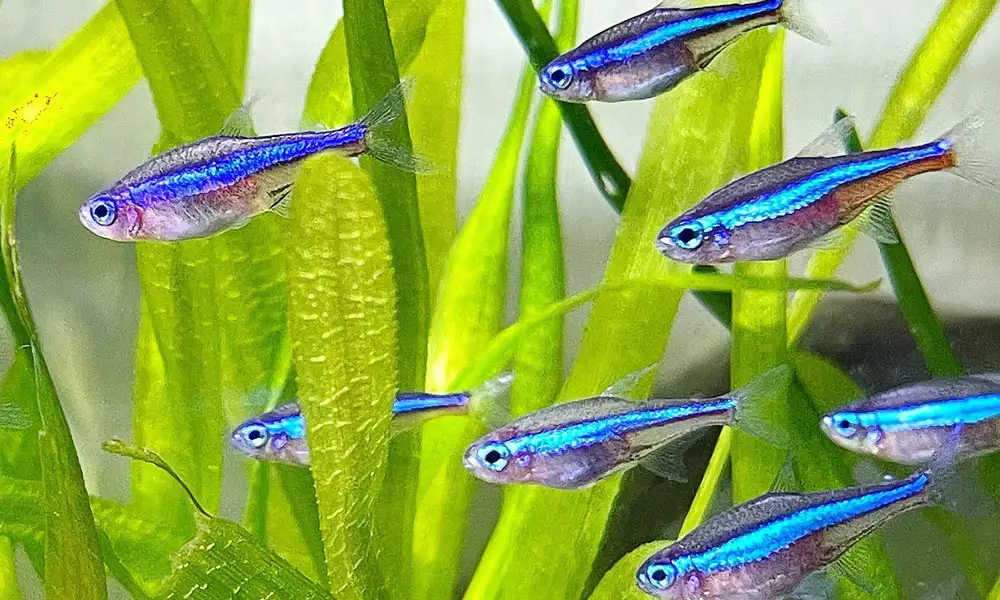
Smaller than the black neon tetra, this little beauty rarely is larger than 1 inch, making it suitable for a 10-gallon fish tank. It also sports a neon horizontal stripe along the sides but in brilliant blue and green.
Because of their petite size and blueish-green coloring, they look better if you get a school of five fish and put them against a darker background or a gorgeous background of lush green plants. They will move around in the top of your 10-gallon community tank, adding flashes of color and streaks of activity.
| Scientific Name: | Paracheirodon simulans |
| Common Name: | Green Neon Tetra |
| Origin: | South America |
| Family: | Cyprinidae |
| Size: | 1 inch (2.5 cm) |
| Social: | Peaceful |
| Care: | Easy |
| Lifespan: | 2 to 3 years |
| pH: | 7 to 7.5 |
| Temperature: | 75 to 84 F (24 to 29 C) |
| KH: | 4 to 7 dGH |
| Diet: | Omnivore |
| How Many Fish in a 10 Gallon Tank? | 6 |
Harlequin Rasboras (Trigonostigma heteromorpha)
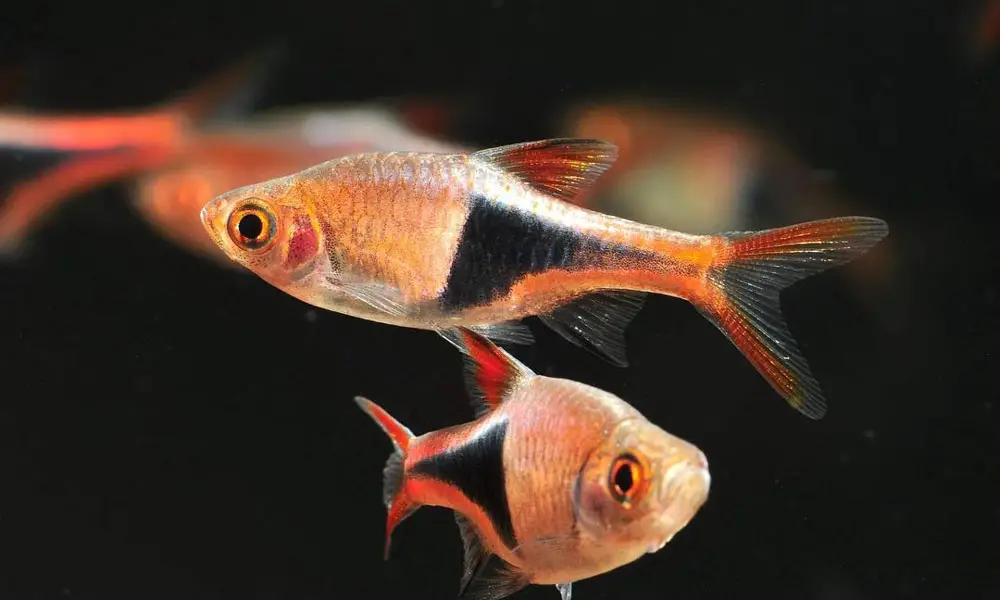
Like Neon Tetras, Harlequin Rasoboras or Red Rasboras are readily available everywhere. This 1.75 inches (4.5 cm) fish has a reddish body that is contrasted with a wedge-shaped black marking (as seen in the picture above), giving it an eye-catching harlequin appearance, hence the name.
Like most fish on this list, you will need to get a small school of at least five fish to best appreciate their beauty in a community tank. Live plants and driftwood are all welcome.
| Scientific Name: | Trigonostigma heteromorpha |
| Common Name: | Red rasbora |
| Origin: | Southeast Asia |
| Family: | Cyprinidae |
| Size: | 1.75 inches (4.5 cm) |
| Social: | Peaceful |
| Care: | Easy |
| Lifespan: | up to 6 years |
| pH: | 6.0 to 7.5 |
| Temperature: | 73 to 82 F (23 to 28 C) |
| KH: | Up to 12 dGH |
| Diet: | Omnivore |
| How Many Fish in a 10 Gallon Tank? | 5 |
Chili Rasboras (Boraras brigittae)
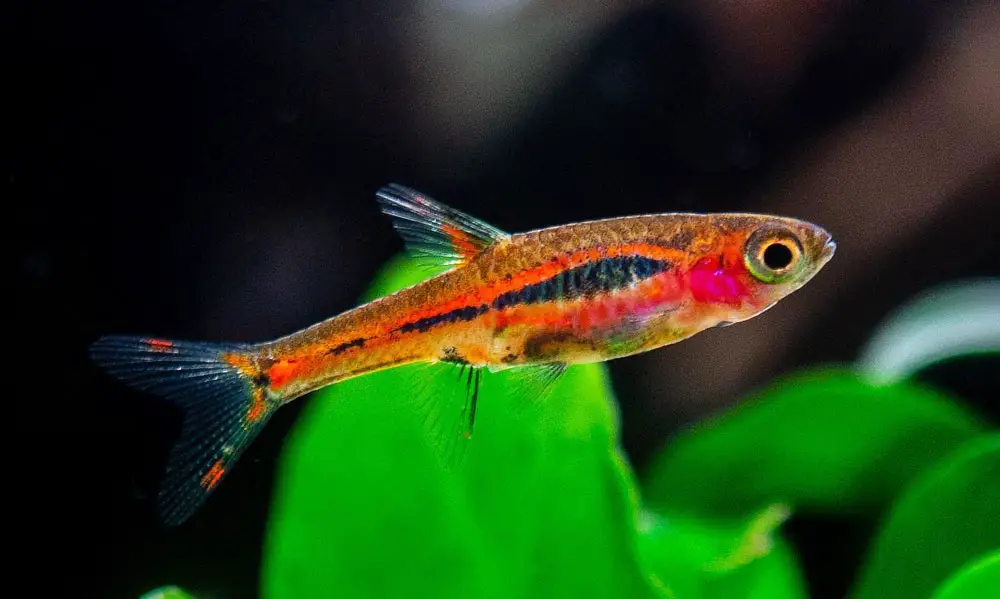
Chili Rasboras, often referred to as Mosquito Rasboras, are a very peaceful species that make excellent candidates for any nano community tank with plenty of live aquarium plants.
These tiny, brightly colored rasboras stay around 0.5 inches (1.3 cm) in size. Rather than exhibiting the traditional warm, red-orange color that is common among most red aquarium fish, these miniature rasboras boast a deep and cool-toned red with distinct black markings.
| Scientific Name: | Boraras brigittae |
| Common Name: | Chili Rasboras, Mosquito Rasbora |
| Origin: | Indonesia |
| Family: | Cyprinidae |
| Size: | 0.5 inches (1.3 cm) |
| Social: | Peaceful |
| Care: | Easy |
| Lifespan: | 4 to 8 years |
| pH: | 4.0 to 7.0 |
| Temperature: | 68 to 82 F (20 to 28 C) |
| KH: | 3 to 12 dGH |
| Diet: | Omnivore |
| How Many Fish in a 10 Gallon Tank? | 8 |
Point Rasboras (Boraras urophthalmoides)
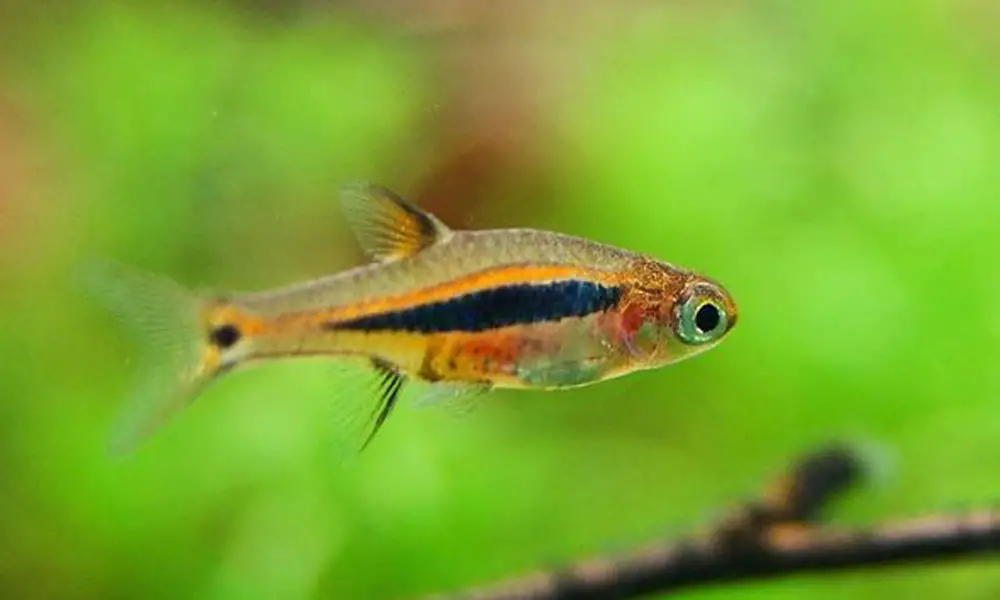
Similar to its cousin the popular Chili Rasboras, this pretty nano fish is colorful, active and can really bring a lot of energy to your 10-gallon community tank.
They usually stay below 0.6 inches (1.6 cm) and school together in a vibrant wave. Like Chili Rasboras, keeping them in groups of at least 6 fish is a must.
| Scientific Name: | Boraras urophthalmoides |
| Common Name: | Point Rasboras |
| Origin: | Thailand |
| Family: | Cyprinidae |
| Size: | 0.6 inches (1.6 cm) |
| Social: | Peaceful |
| Care: | Easy |
| Lifespan: | 4 to 8 years |
| pH: | 6.0 to 7.0 |
| Temperature: | 68 to 82 F (20 to 28 C) |
| KH: | 8 to 12 dGH |
| Diet: | Omnivore |
| How Many Fish in a 10 Gallon Tank? | 6 |
Lambchop Rasbora (Trigonostigma espei)
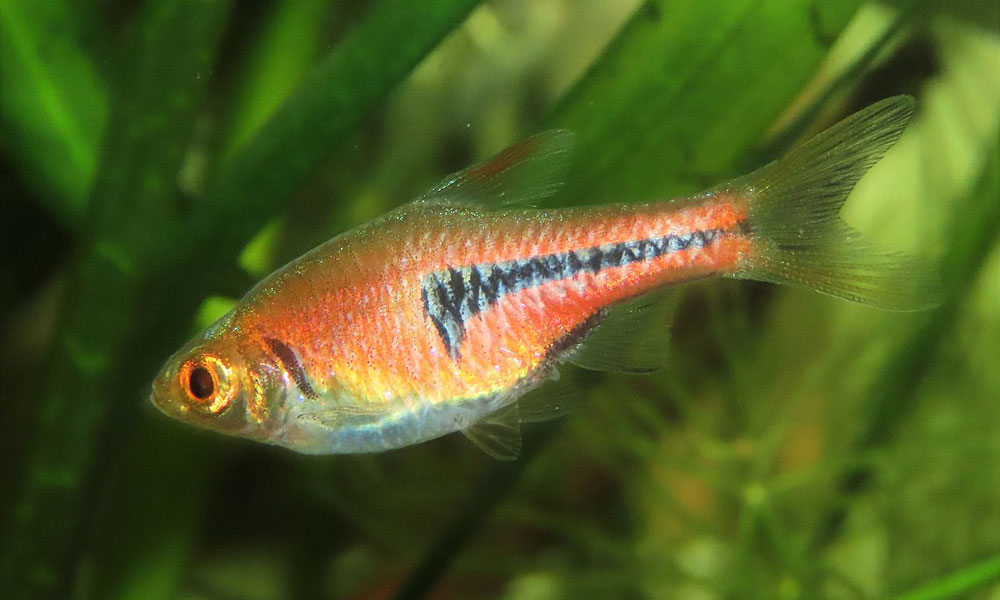
the last but not the least Rasbora on our list is the Lambchop Rasbora because they have the distinctive coloration. They sport a brighter orange body and also feature a distinct black mark that resembles a lambchop, starting in the middle of the body and ending on the tail.
Due to their unique marking and peaceful nature, a group of their own kind can nicely pop out against the waving greenery of the real live plants.
| Scientific Name: | Trigonostigma espei |
| Common Name: | Lambchop Rasbora |
| Origin: | Thailand |
| Family: | Cyprinidae |
| Size: | 1.5 inches (3.8 cm) |
| Social: | Peaceful |
| Care: | Easy |
| Lifespan: | 4 to 8 years |
| pH: | 6.0 to 7.0 |
| Temperature: | 72 to 79 F (22 to 26 C) |
| KH: | 2 to 10 dGH |
| Diet: | Omnivore |
| How Many Fish in a 10 Gallon Tank? | 6 |
Dwarf Gourami (Trichogaster lalius)

Everyone loves Gourami species because of their ease of care, unique behavior, and stunning appearance. However, not all Gouramis are good candidates for smaller aquariums, some species grow too large for 10-gallon tanks.
Dwarf gouramis are one of the few species that are well suited to 10-gallon community aquariums. They will grow to 2 inches (5 cm), and you can keep them with fish similar size like neon tetras and Rasboras mentioned above. We also like adding a pair of dwarf gouramis to 10-gallon tanks as they will swim together.
| Scientific Name: | Trichogaster Ialius |
| Common Name: | Dwarf gourami, flame gourami, powder blue gourami, sunset gourami |
| Origin: | India, Bengal, Assam, and Bangladesh |
| Family: | Belontiidae |
| Size: | 2 inches (5 cm) |
| Social: | Peaceful |
| Care: | Intermediate |
| Lifespan: | 4 to 6 years |
| pH: | 6.0 to 7.5 |
| Temperature: | 72 to 82 F (22 to 28 C) |
| KH: | 4 to 10 dGH |
| Diet: | Omnivore |
| How Many Fish in a 10 Gallon Tank? | A pair/Single |
Honey Gourami (Trichogaster chuna)
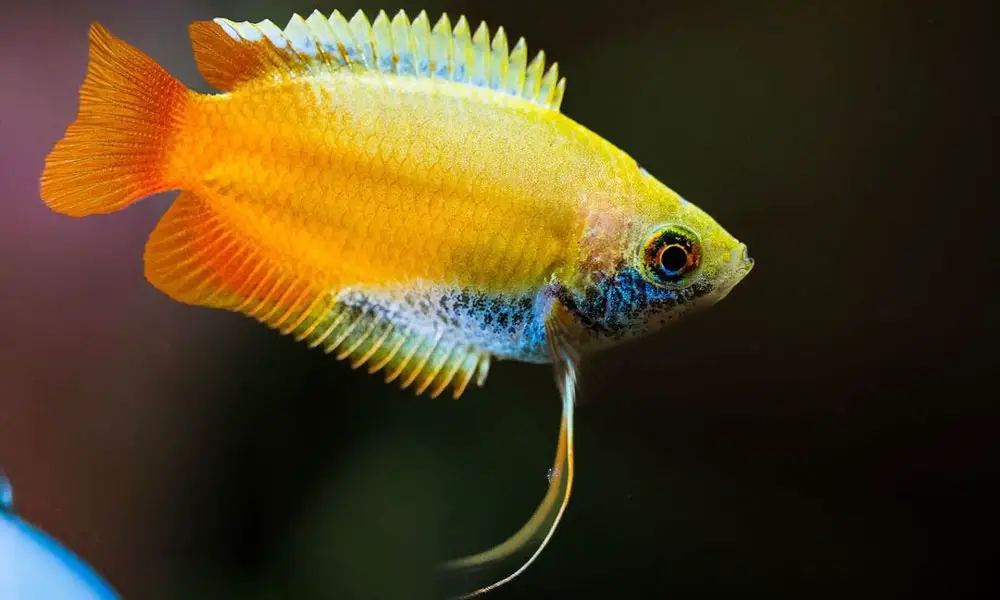
Honey Gouramis are another well-known small member of this family. They are even smaller than Dwarf gouramis and stay around 2 inches (5 cm). Peaceful and undemanding, these fish get along with almost any other species in a 10-gallon fish tank.
As a centerpiece fish, this species stands out with its bright yellow or gold body with two modified ventral fins. Furthermore, Honey Gouramis are more peaceful than Dwarf Gouramis and are less susceptible to Dwarf Gourami Iridovirus (DGIV) disease.
| Scientific Name: | Trichogaster chuna |
| Common Name: | Honey gourami, honey dwarf gourami, red flame gourami, dwarf fire gourami, red robin gourami |
| Origin: | India |
| Family: | Osphronemidae |
| Size: | 2 inches (5 cm) |
| Social: | Peaceful |
| Care: | Intermediate |
| Lifespan: | 4 to 6 years |
| pH: | 6.0 to 8 |
| Temperature: | 74 to 82 F (23 to 28 C) |
| KH: | 4 to 10 dGH |
| Diet: | Omnivore |
| How Many Fish in a 10 Gallon Tank? | A pair/Single |
Fancy Guppy (Poecilia reticulata)

A 10-gallon guppy tank is colorful and lively, which I recommend to aquarists of all experience levels. One reason why guppies have been a staple in the aquarium hobby is they are highly adaptable in many different water conditions.
Fancy guppies are readily available for purchase and come in all sorts of sizes, shapes and colors. Most of them stay small, usually under 2 inches (5 cm). Guppies are great at reproducing, so you don’t need to purchase many of them for a 10-gallon tank. 3-5 fancy guppies should make a good start.
| Scientific Name: | Poecilia reticulata |
| Common Name: | Guppy |
| Origin: | South America |
| Family: | Poeciliidae |
| Size: | 2 inches (5 cm) |
| Social: | Peaceful |
| Care: | Easy |
| Lifespan: | 2 to 3 years |
| pH: | 6.5 to 8 |
| Temperature: | 68 to 78 F (20 to 26 C) |
| KH: | 6 to 8 dGH |
| Diet: | Omnivore |
| How Many Fish in a 10 Gallon Tank? | 3 to 5 |
Endler’s Livebearers (Poecilia wingei)

Endlers, the little cousins of guppies, surely have their place among the most colorful freshwater fish. Endlers livebearers are smaller than guppies and pretty easy to care for as well.
As with guppies, female Endlers are larger than males because of their rounder abdomen. Usually, males will only grow up to an inch (2.5 cm) in length while females can reach 1.8 inches (4.5 cm). 10-gallon tank should be enough for a small school of 4-6 Endler’s livebearers, although you may need to have 20 or more to get some interesting shoaling behaviors.
| Scientific Name: | Poecilia wingei |
| Common Name: | Endler’s Livebearers, Endlers |
| Origin: | Venezuela |
| Family: | Poeciliidae |
| Size: | 1 inch (2.5 cm) |
| Social: | Peaceful |
| Care: | Easy |
| Lifespan: | 2 to 3 years |
| pH: | 5.5 to 8 |
| Temperature: | 64 to 82 F (18 to 28 C) |
| KH: | 10 to 30 dGH |
| Diet: | Omnivore |
| How Many Fish in a 10 Gallon Tank? | 4 – 6 |
Middle Dwellers
For 10-gallon community tanks, here are many peaceful middle dwellers that remain untroubled to what’s happening in the upper or bottom parts of the water column!
Ember Tetras (Hyphessobrycon amandae)
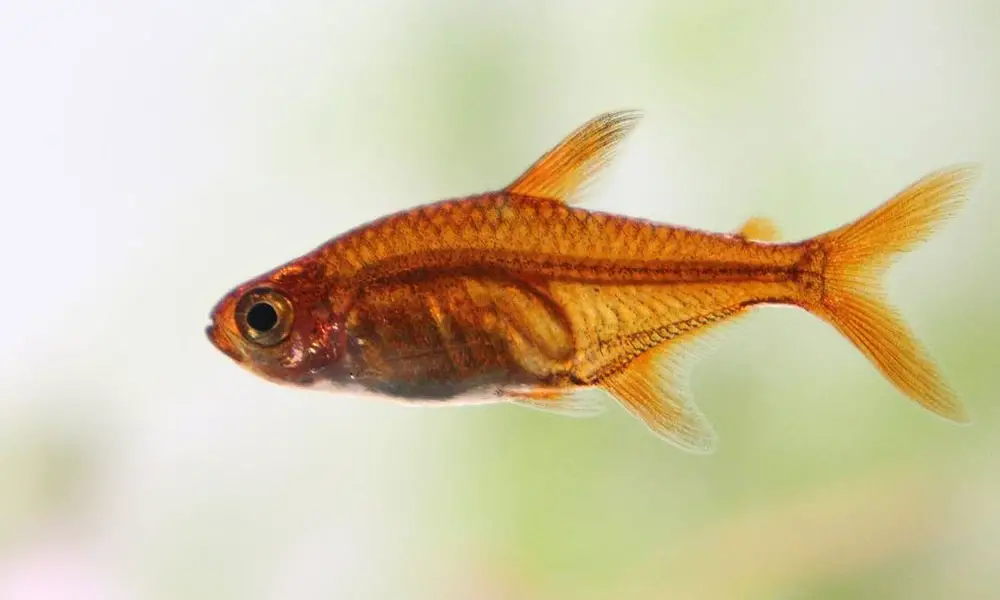
For years, Ember Tetras have been a beloved choice for freshwater nano aquariums. Their unique orange hue is bound to catch the eye of countless admirer! At only an inch long, this tiny species will add beauty and life to your tank in no time.
A small 10-gallon aquarium with a lush forest of live aquarium plants would look fantastic against with a school of this flame-colored fish. Because they can be a bit shy and have a diminutive size, it’s best to keep them in a school of at least six fish (of the same species).
| Scientific Name: | Hyphessobrycon amandae |
| Common Name: | Ember Tetras |
| Origin: | Brazil |
| Family: | Characidae |
| Size: | 1 inch (2.5 cm) |
| Social: | Peaceful |
| Care: | Easy |
| Lifespan: | up to 10 years |
| pH: | 5.5 to 7.5 |
| Temperature: | 72 to 82 F (22 to 28 C) |
| KH: | 5 to 17 dGH |
| Diet: | Omnivore |
| How Many Fish in a 10 Gallon Tank? | 6 – 8 |
Flame Tetra (Hyphessobrycon flammeus)
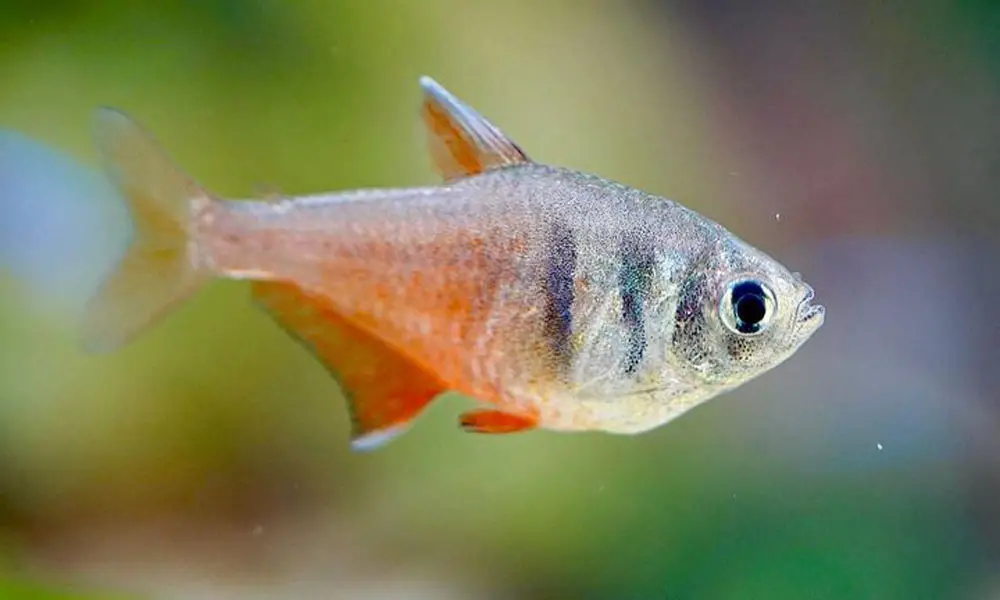
Another fairly small species of Tetra in the fish trade, the Flame Tetra grow to around 1.6 inches (4 cm) long and do best in schools of at least six. They are very active and often stick together as they swim to and fro.
As its name implies, their back and fins are colored in a brilliant red with black on the leading edge and tip of the anal fin, giving them a very vibrant appearance. At one time, these cute fish were quite popular because they are adaptable enough to handle a wide range of temperatures.
| Scientific Name: | Hyphessobrycon flammeus |
| Common Name: | Flame tetra, Von Rio tetra, fire tetra, red tetra |
| Origin: | Brazil |
| Family: | Characidae |
| Size: | 1.6 inches (4 cm) |
| Social: | Peaceful |
| Care: | Easy |
| Lifespan: | 3 to 5 years |
| pH: | 5.5 to 7.5 |
| Temperature: | 72 to 82 F (22 to 28 C) |
| KH: | 3 to 15 dGH |
| Diet: | Omnivore |
| How Many Fish in a 10 Gallon Tank? | 5 |
Black Phantom Tetra (Megalamphodus megalopterus)
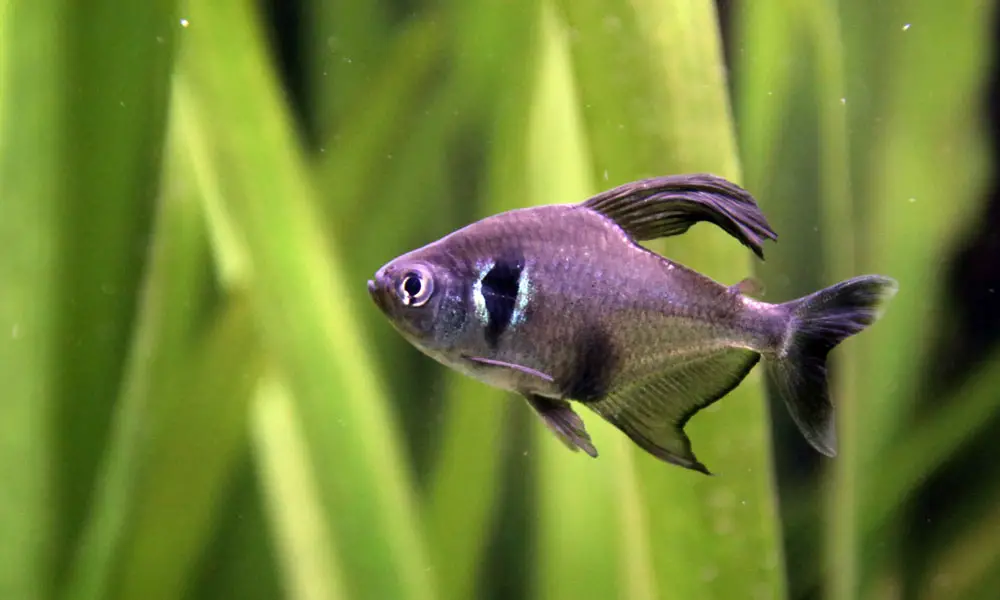
Natives to Brazil and Paraguay, the Black Phantom Tetra is readily available in most fish stores. This species can be distinguished by an “eye patch” marking behind the gills, giving them a phantom-like appearance.
At 1.75 inches (4.4 cm) in length, you could house a group of five or more black phantom tetra in a 10-gallon planted aquarium. They are peaceful, easy to care for and quite hardy, that’s why we find ourselves recommending it over and over again.
| Scientific Name: | Megalamphodus megalopterus |
| Common Name: | Black phantom petra, phantom tetra |
| Origin: | Brazil |
| Family: | Characidae |
| Size: | 1.75 inches (4.4 cm) |
| Social: | Peaceful |
| Care: | Intermediate |
| Lifespan: | up to 5 years |
| pH: | 6 to 7.5 |
| Temperature: | 72 to 82 F (22 to 28 C) |
| KH: | 3 to 18 dGH |
| Diet: | Omnivore |
| How Many Fish in a 10 Gallon Tank? | 5 |
Black Widow Tetra (Gymnocorymbus ternetzi)
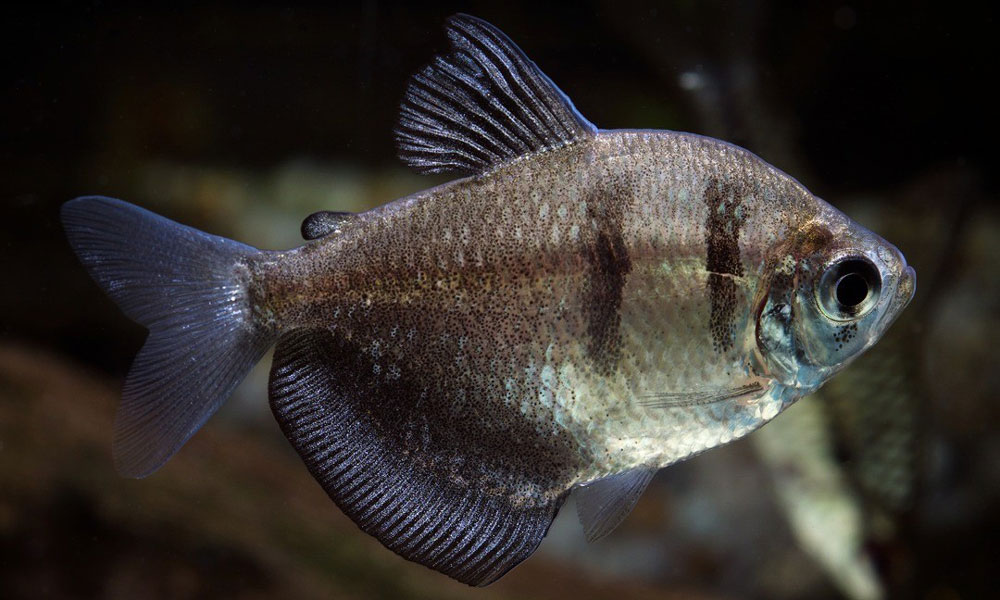
Also known as the black skirt, this best-known tetra species has distinctive black dorsal and anal fins. In nature, this species actually comes in a range of colors from white to pink, but different varieties with various colors and fin shapes have been developed through selective breeding.
The Black Widow Tetra can reach a size of 2 inches (5.0 cm), these active swimmers would appreciate a 20-gallon tank or larger that is well planted. However, with proper care and in 10-gallon tanks, you can keep a small school of four individuals.
| Scientific Name: | Gymnocorymbus ternetzi |
| Common Name: | Black tetra, black skirt |
| Origin: | Rio Paraguay, Rio Guapore, Bolivia |
| Family: | Characidae |
| Size: | 2 inches (5.0 cm) |
| Social: | Peaceful |
| Care: | Easy |
| Lifespan: | up to 5 years |
| pH: | 5.8 to 8.5 |
| Temperature: | 68 to 79 F (20 to 26 C) |
| KH: | up to 15 dGH |
| Diet: | Omnivore |
| How Many Fish in a 10 Gallon Tank? | 4 |
X-Ray Tetra (Pristella maxillaris)
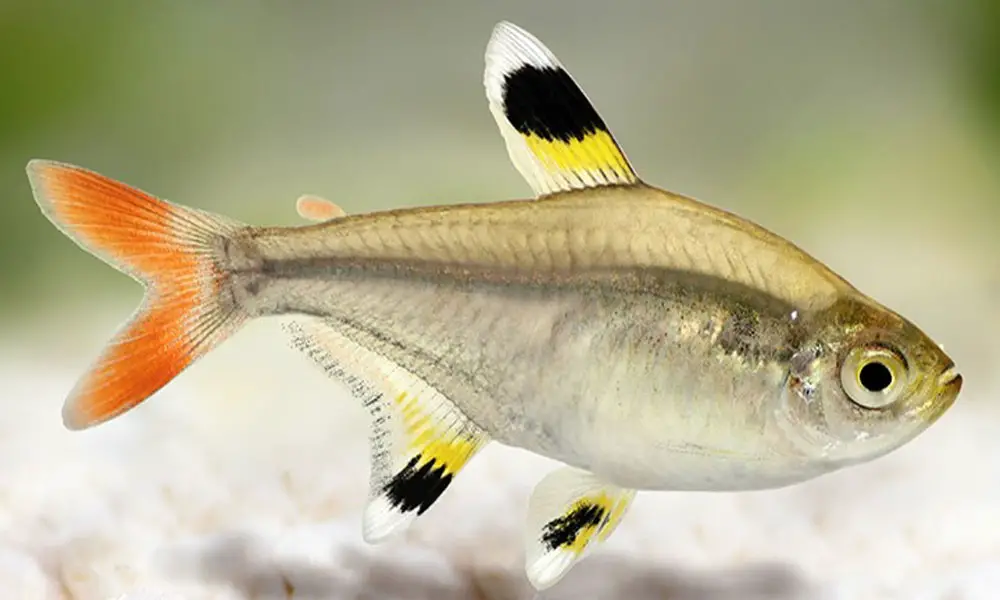
The X-Ray Tetra, or pristella tetra hails from a wide range of habitats from Amazon and Orinoco basins in Brazil to coastal rivers of Venezuela, where it is found in both acidic and alkaline waters. Like Black Widow Tetra and Black Phantom Tetra, its common name comes the see-through body and visible organs as they swim.
It is small, up to around 1.75 inches (4.5 cm) and lives in large groups, preferably of a half-dozen or more. When kept in a 10 gallons fish tank, go for four or more individuals as 6 of them would be a little crowded.
| Scientific Name: | Pristella maxillaris |
| Common Name: | X-ray fish, X-ray tetra |
| Origin: | Brazil, Guyana, Orinoco, and Venezuela. |
| Family: | Characidae |
| Size: | 1.75 inches (4.5 cm) |
| Social: | Peaceful |
| Care: | Easy |
| Lifespan: | 3 to 5 years |
| pH: | 5.8 to 8.5 |
| Temperature: | 64 to 82 F (18 to 28 C) |
| KH: | 4 to 8 dGH |
| Diet: | Omnivore |
| How Many Fish in a 10 Gallon Tank? | 4 |
Glowlight Tetra (Hemigrammus erythrozonus)

As one of the fairly new species of tetra introduced to the aquarium trade, the Glowlight Tetra is a highly sought-after commodity. Like the glowlight rasbora, the glowlight tetra is characterized by its iridescent red stripe running horizontally along the length of its slender body.
It’s a peaceful schooling fish that grows to 1.5 inches (3.8 cm) in size, and five would do great in 10-gallon tank. If you want to make a visually stunning 10-Gallon aquascape, we highly recommend putting five of them in a well planted tank with a red centerpiece fish like a pair gourami or red betta fish.
| Scientific Name: | Hemigrammus erythrozonus |
| Common Name: | Glowlight tetra, glolight, fire neon |
| Origin: | Guyana |
| Family: | Characidae |
| Size: | 1.5 inches (3.8 cm) |
| Social: | Peaceful |
| Care: | Easy |
| Lifespan: | 3 to 5 years |
| pH: | 5.8 to 7.5 |
| Temperature: | 74 to 82 F (24 to 28 C) |
| KH: | up to 15 dGH |
| Diet: | Omnivore |
| How Many Fish in a 10 Gallon Tank? | 5 |
Dwarf or Teacup Platies (Xiphophorus sp.)
Platies like guppies and endlers are Livebearing fish, they give birth to live fry instead of laying eggs. Although most platies grow larger (up to 3 inches or 7.6 cm), with careful selection you can find small “teacup” varieties of platies that are around 1 inch (2.5 cm) in size and perfect for a 10-gallon tank.
In 10-gallon community tanks, a trio of dwarf platies (1 male and 2 females) is a good starting point. Remember most livebearers prefer higher pH and enjoy harder water, so make sure to read up on the water requirements of these fish.
| Scientific Name: | Xiphophorus sp. |
| Common Name: | Dwarf Platies, Teacup Platies, Teacup Red Wag Platies |
| Origin: | – (Selective Breeding) |
| Family: | Poeciliidae |
| Size: | 1 inch (2.5 cm) |
| Social: | Peaceful |
| Care: | Easy |
| Lifespan: | up to 5 years |
| pH: | 6.8 to 8.5 |
| Temperature: | 70 to 82 F (21 to 28 C) |
| KH: | 10 to 28 dGH |
| Diet: | Omnivore |
| How Many Fish in a 10 Gallon Tank? | A trio (1 male and 2 females) |
Mid to Bottom Level
These species prefer swimming at the bottom and mid levels of the tank:
Neon Tetra (Paracheirodon innesi)

Any list of colorful fish would not be complete without the dazzling neon tetra. Despite being small – they usually grow up to around 1.5 inch (3.8 cm) long, neons are a very active shoaling species that prefer living in groups of a half dozen or more.
These small peaceful fish are often mistaken for cardinal tetras. The difference between the two is that cardinals have the bright red stripe running along their entire bodies, while neons have a red stripe that only extends from the middle of the body.
| Scientific Name: | Paracheirodon innesi |
| Common Name: | Neon tetra, neon fish |
| Origin: | Colombia, Peru, Brazil |
| Family: | Characidae |
| Size: | 1.5 inch (3.8 cm) |
| Social: | Peaceful |
| Care: | Intermediate |
| Lifespan: | 5 to 10 years |
| pH: | 7 to 7.5 |
| Temperature: | 68 to 79 F (20 to 26 C) |
| KH: | up to 10 dGH |
| Diet: | Omnivore |
| How Many Fish in a 10 Gallon Tank? | 6 |
Otos (Otocinclus Spp.)
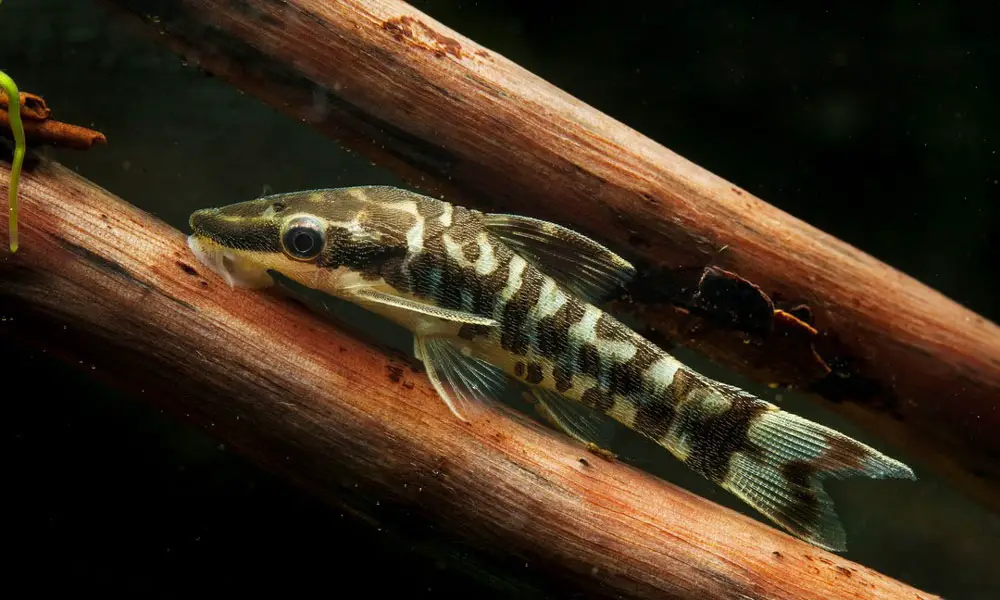
Commonly known as “dwarf suckers” or “otos”, these small catfish are super cute. Members in this family are recognized by the plates of armor or bony covering body and an underslung suckermouth.
There are 19 described species in this genus with most typically stay below 2 inches (5 cm) in size at adulthood. These fish are also prized for their ability to keep algae in check, they are an excellent addition to 10-gallon tanks as one of the best tank cleaners.
| Species | Size |
|---|---|
| Otocinclus arnoldi | 1.9″ (4.8 cm) |
| Otocinclus batmani | 1.5″ (3.8 cm) |
| Otocinclus bororo | 1.2″ (3.1 cm) |
| Otocinclus caxarari | 1″ (2.5 cm) |
| Otocinclus cocama | 1.7″ (4.4 cm) |
| Otocinclus flexilis | 2.7″ (6.8 cm) |
| Otocinclus hasemani | 1.1″ (2.7 cm) |
| Otocinclus hoppei | 1.3″ (3.3 cm) |
| Otocinclus huaorani | 1.25″ (3.2 cm) |
| Otocinclus juruenae | 0.9 ~ 1.3 inches (2.2 to 3.3 cm) |
| Otocinclus macrospilus | 1.4″ (3.5 cm) |
| Otocinclus mangaba | 1.3″ (3.3 cm) |
| Otocinclus mimulus | 1.7″ (4.4 cm) |
| Otocinclus mura | 1.4″ (3.5 cm) |
| Otocinclus tapirape | 0.9″ (2.4 cm) |
| Otocinclus vestitus | 1.3″ (3.3 cm) |
| Otocinclus vittatus | 1.3″ (3.3 cm) |
| Otocinclus xakriaba | 1.2″ (3.1 cm) |
Bottom Dwellers
Bottom-dwelling fish are necessary for any community tank. Not only do they complete the look of your tank, but they also help keep debris from accumulating in the substrate.
For a 10-gallon aquarium, the most commonly kept members are corys and snails. Here are some suitable species.
Panda Cory (Corydoras panda)

With their docile attitude, Panda Corys can be a great bottom dweller. They have an interesting appearance with black and white patterns that resemble a panda. Like most animals on this list, Panda Corys are social fish and must be kept in schools of their own kind.
Given that they stay below 2 inches (5 cm) and how peaceful they are, a group of 4-5 is perfectly suitable for a 10-gallon community tank.
| Scientific Name: | Corydoras panda |
| Common Name: | Panda catfish, panda cory, panda corydoras |
| Origin: | Peru |
| Family: | Callichthyidae |
| Size: | 2 inches (5 cm) |
| Social: | Peaceful |
| Care: | Intermediate |
| Lifespan: | up to 10 years |
| pH: | 6 to 7 |
| Temperature: | 68 to 77 F (20 to 25 C) |
| KH: | 2 to 12 dGH |
| Diet: | Omnivore |
| How Many Fish in a 10 Gallon Tank? | 4 ~ 5 |
Pygmy Corydoras (Corydoras pygmaeus)
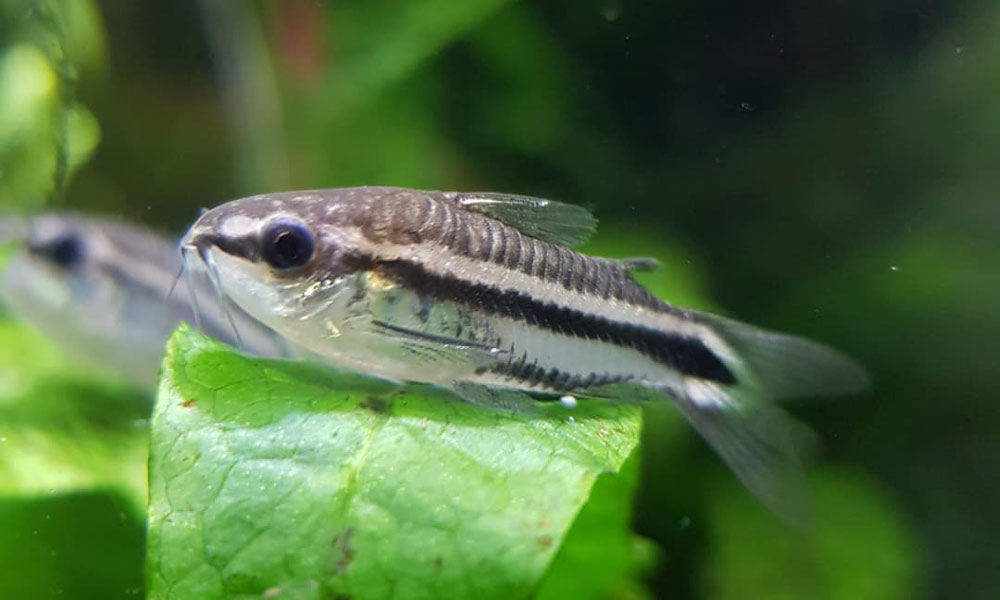
Pygmy Corydoras would be a good fit for aquarists interested in nano fish. As one of the smallest tropical fish in the hobby, they are usually around one inch long. They prefer to be with more of their kind, you can go up to 6 or so in a 10-gallon aquarium.
A soft sandy substrate is appreciated as they like to burrow. Live plants should be added to the aquarium to keep things natural and help these fish thrive.
| Scientific Name: | Corydoras pygmaeus |
| Common Name: | Pygmy Corydoras, Pygmy Corys |
| Origin: | Brazil |
| Family: | Callichthyidae |
| Size: | 1 inch (2.5 cm) |
| Social: | Peaceful |
| Care: | Easy |
| Lifespan: | up to 3 years |
| pH: | 6.5 to 7.5 |
| Temperature: | 72 to 79 F (22 to 26 C) |
| KH: | 6 to 10 dGH |
| Diet: | Omnivore |
| How Many Fish in a 10 Gallon Tank? | 6 |
Salt and Pepper Pygmy Cory Catfish (Corydoras habrosus)
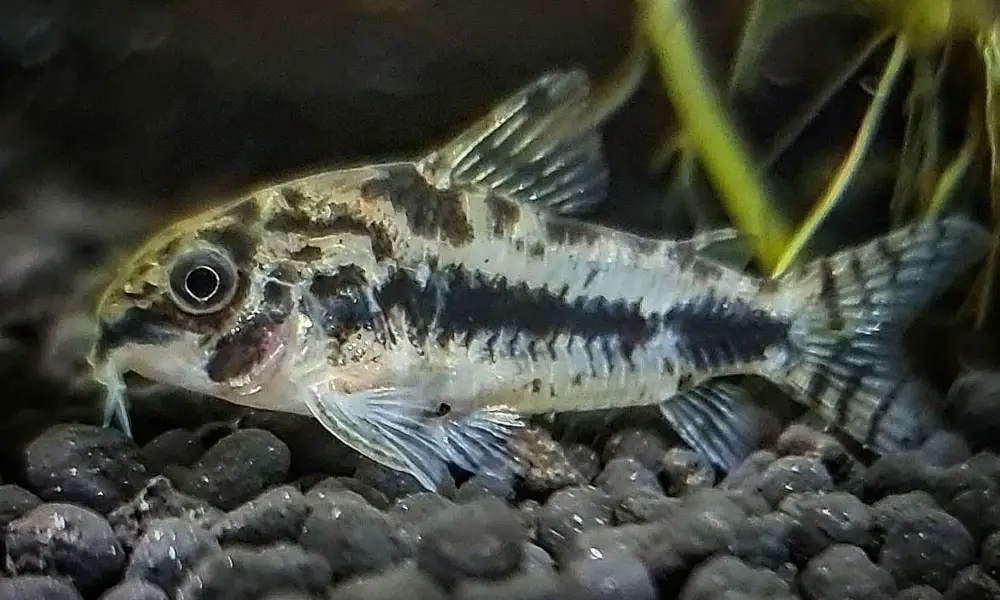
This species is not often available in pet shops, but it’s worth checking out online. The Salt and Pepper Pygmy Corys is similar in appearance to a longtime favorite, the Pepper Cory Catfish (Corydoras paleatus) but much smaller, reaching a maximum size of 1.4 inches (3.5 cm).
They are very peaceful and should be kept in groups of at least 6 or more since they are shoaling fish. Soft sandy substrate is recommended for them to burrow if needed.
| Scientific Name: | Corydoras habrosus |
| Common Name: | Salt and Pepper Pygmy Cory Catfish |
| Origin: | Colombia and Venezuela |
| Family: | Callichthyidae |
| Size: | 1.4 inches (3.5 cm) |
| Social: | Peaceful |
| Care: | Easy |
| Lifespan: | up to 3 years |
| pH: | 6.2 to 7.2 |
| Temperature: | 72 to 79 F (22 to 26 C) |
| KH: | 6 to 10 dGH |
| Diet: | Omnivore |
| How Many Fish in a 10 Gallon Tank? | 6 |
Snails & Shrimps
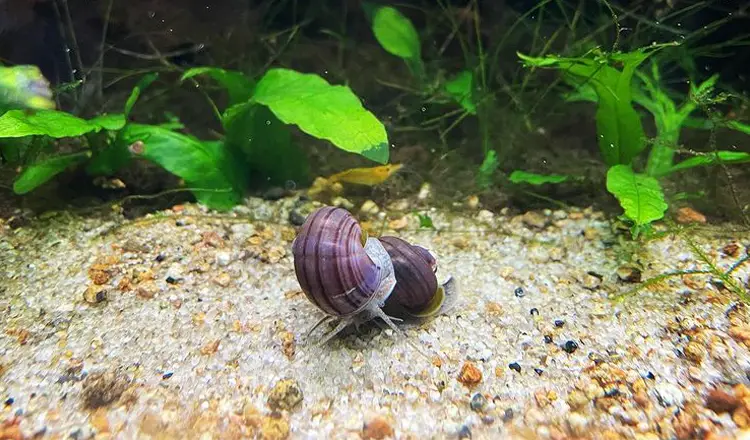
Invertebrates like shrimp and snails are great bottom feeders and scavengers. They are not just interesting creatures to watch – they also serve a beneficial role in the aquarium’s ecosystem!
Both of these critters help keep the tank clean by consuming algae, animal debris, and leftover fish food. Therefore, with their assistance your aquarium will never be short on beauty or tidiness.
Which Ones Do You Like Most?
Now that you know some of the 10-gallon community tank fish suggestions, it’s time to choose one! Consider your goals and preferences as you decide which ones to keep and enjoy.
Beyond what water level the fish prefer, size, water conditions, and which other species they are compatible with, must also be considered.
Do your research to make sure everyone in the tank will get along and be happy, because a 10-gallon tank has limited space. With some preparation and thoughtfulness, you can have a beautiful 10-gallon community tank with fish that all get along!
Happy fishkeeping!
